|
|
|
Jeux
Sans Frontières 1975
European International Series
Entrants
1975:
Belgium (B) • Switzerland (CH) • West Germany (D) •
France (F) • Great Britain (GB) • Italy (I) • Netherlands (NL)
Presenters / Commentators of International Competitions:
Paule Herreman (RTB - B)
Mike Verdrengh, Marc van Poucke and Regine Clauwaert (BRT - B)
Georges Kleinmann (SSR - CH)
Ezio Guidi and Elisabeth Brindisi (TSI - CH)
Jan Hiermeyer and Heidi Abel (SRG - CH)
Erhard Keller, Karl-Heinz Wocker, Manfred Erdenberger
and Marie-Louise Steinbauer (ARD-WDR - D)
Guy Lux, Simone Garnier and Claude Savarit
(A2 - F)
Stuart Hall and Eddie Waring (BBC - GB)
Giulio Marchetti and Rosanna Vaudetti
(RAI - I)
Dick Passchier and Barend Barendse
(NCRV - NL)
International
Referees:
Gennaro Olivieri
Guido Pancaldi
National Referees:
Mike Swann (GB)
Collaborator / Assistant Referee:
André Lange
Production Credits:
National Games Designers: Stuart Furber (GB);
National Producers: Diane Lange and Nicolas Résimont (RTB - B),
Lode Hendrickx, Jef Savenberg and Herman Verelst (BRT - B),
Jean Niedermann (SSR - CH),
Marius Berger (SRG - CH),
Sergio Cavaglieri (TSI - CH),
Marita Theile (D),
Guy Lux and Claude Savarit (F),
Barney Colehan (GB),
Luciano Vecchi (I),
Bernard Prins and Dick Van’t Sant (NL);
National Directors: Lode Hendrickx (BRT - B),
Jean Bovon and Jean-Marie Schorderet (SRG - CH),
Günther Hassert (D),
Pierre Badel and Jean Cohen (F),
Geoff Wilson (BBC),
Gian Maria Tabarelli (I),
Matthias Meuser (NL)
Produced by the European Broadcasting Union and
RTB-BRT (B), SSR-SRG-TSI (CH), ARD-WDR (D),
ANTENNE 2 (F), BBC Manchester (GB), RAI (I), NCRV (NL)
|
Key:
International Heats
●
= Qualified for International Final /
●
= Heat Winner (Silver Trophy)
International Final
●
=
Gold Trophy /
●
=
Silver Trophy /
●
=
Bronze Trophy Trophy
▲ = Promoted to Position / ▼ =
Demoted to Position
DST = Daylight Saving Time
(ONLY Great Britain and Italy observed DST) |
|
|
B |
Jeux
Sans Frontières 1975 |
Heat
1 |
|
Event Staged: Tuesday 20th May 1975
Venue:
Alfred Verweeplein, Knokke, Belgium
European Transmissions (Local Timings):
BRT (B): Tuesday 20th May 1975, 9.05-10.20pm (Live)
RTB (B): Tuesday 20th May 1975, 9.05-10.10pm (Live)
SRG (CH): Tuesday 20th May 1975, 9.05-10.20pm (Live)
WDR 1 (D): Tuesday 20th May 1975, 9.05-10.30pm (Live)
RAI Due (I): Tuesday 20th May 1975, 9.05-10.30pm (Live)
Nederland 1 (NL): Tuesday 20th May 1975, 9.05-10.25pm (Live)
SSR (CH): Wednesday 21st May 1975, 8.15-9.35pm
TSI (CH): Wednesday 21st May 1975, 9.00-10.15pm
BBC1 (GB exc. Wales): Wednesday 27th August 1975,
6.55-8.10pm
BBC1 Wales (CYM): Sunday 31st August 1975,
1.55-3.10pm
Winners' Trophy presented by: Mike Verdrengh |
|
Theme:
The Village Fair |
|
Teams:
Knokke-Heist (B) v. Riva San Vitale (CH) v. Oppenheim (D) v.
Neuilly-sur-Seine (F) v. St. Ives (GB) v. Cosenza (I) v. Hoogvliet (NL) |
|
Team Members
included:
Knokke-Heist (B) - Paul van der Kochkerholm;
Riva San Vitale (CH) - Rita Bricholla, Oriallo Catalani and
Thierre Luigi Valconi;
Oppenheim (D) - Bernt Borsnerf, Molly Copriva and Helmut Ring;
Neuilly-sur-Seine (F) - Jacques Boutain;
St. Ives (GB) - Jack Aitkin, Monroe Broad, Billy Chappel,
Charles Eddy, Joanna Eddy, Malcolm Furneaux, Brian Hannibal, Maureen Hopley,
Sarah Kinwell, Tommy Meredith, Keith Naylor, Margaret Paynter, Ivor Phillips,
Dudley Richards, Jane Schwab, Jeanette Trevorrow, Derek White, Hilary Wilson
Reserves: Leslie Angove, Sandra Burgess;
Cosenza (I) - Fausto Brullio;
Hoogvliet (NL) - Ben Paasman (Team Captain). |
|
Games
(Official Titles): De Floche (The Tassel), De Raket (The Net), Het
Hobbelpaard (The Rocking Horse), De Getemde Beer (The Tamed Bear), De
Paardenmolen (The Roundabout), De Smoutbollen (The Fritters), Blikken Gooien
(Tin Pitching) and De Sterke Man (The Strong Man);
Fil Rouge: De Autoskooter (Scooter);
Jokers: Carousel Horses |
|
Game Results and Standings |
|
Games |
|
Team /
Colour |
1 |
2 |
3 |
4 |
5 |
6 |
7 |
FR |
8 |
Points Scored
(Joker games shown in red) |
|
B |
4 |
8 |
5 |
3 |
6 |
5 |
--- |
7 |
2 |
|
CH |
--- |
3 |
5 |
12 |
3 |
4 |
4 |
3 |
3 |
|
D |
5 |
--- |
12 |
2 |
4 |
4 |
4 |
6 |
6 |
|
F |
1 |
3 |
--- |
4 |
6 |
6 |
10 |
3 |
5 |
|
GB |
2 |
5 |
6 |
--- |
2 |
1 |
6 |
3 |
4 |
|
I |
3 |
1 |
2 |
2 |
--- |
4 |
4 |
6 |
1 |
|
NL |
6 |
12 |
1 |
5 |
1 |
--- |
1 |
6 |
7 |
Running Totals
(Leading teams shown in red) |
|
B |
4 |
12 |
17 |
20 |
26 |
31 |
31 |
38 |
40 |
|
CH |
0 |
3 |
8 |
20 |
23 |
27 |
31 |
34 |
37 |
|
D |
5 |
5 |
17 |
19 |
23 |
27 |
31 |
37 |
43 |
|
F |
1 |
4 |
4 |
8 |
14 |
20 |
30 |
33 |
38 |
|
GB |
2 |
7 |
13 |
13 |
15 |
16 |
22 |
25 |
29 |
|
I |
3 |
4 |
6 |
8 |
8 |
12 |
16 |
22 |
23 |
|
NL |
6 |
18 |
19 |
24 |
25 |
25 |
26 |
32 |
39 |
|
|
|
Result |
Team |
Points |
Final Scoreboard |
|
1st
2nd
3rd
4th
5th
6th
7th |
D
• Oppenheim
●
B • Knokke-Heist ●
NL • Hoogvliet
F • Neuilly-sur-Seine
CH • Riva San Vitale
GB • St. Ives
I • Cosenza |
43
40
39
38
37
29
23 |
 |
|
The Venue |
|
Knokke, Belgium
This heat was held in Alfred Verwee Square, located in front of the Town Hall
in the centre of Knokke. The square was named after Alfred Jacques Verwee, a
Belgian painter and etcher. Born in St.-Joost-ten-Node in Brussels in 1838, he
was known for his depictions of animals and landscapes. At the time of staging
the square was used for the weekly market, but today the square stands on top
of an underground car park, and is surrounded by shops and open-air cafés. |
|
The Games in Detail |
|
Game 1 - De Floche (The Tassel)
1 boy (blindfolded) + Lady Captain. The contestants standing on a turning
platform coated with soft soap will have to try and pull the tassel.
Elimination contest.
| |
|
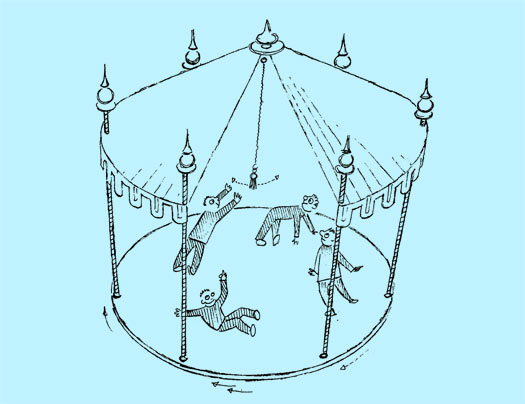 |
|
Image ©
BRT / VRT, 1975 |
| |
|
Running Scores and Positions:
1st Hoogvliet (NL) (6pts awarded / 6pts
total)
2nd Oppenheim (D) (5pts / 5pts)
3rd Knokke-Heist (B) (4pts / 4pts)
4th Cosenza (I) (3pts / 3pts)
5th St. Ives (GB) (2pts / 2pts)
6th Neuilly-sur-Seine (F) (1pt / 1pt)
7th Riva San Vitale (CH) (--- / 0pts) |
Game 2 - De Raket (The Net)
2 girls and 2 boys. One boy throws balls over a net in the
direction of girls on a fairground flying ride who must catch the balls and
throw them into a container.
| |
|
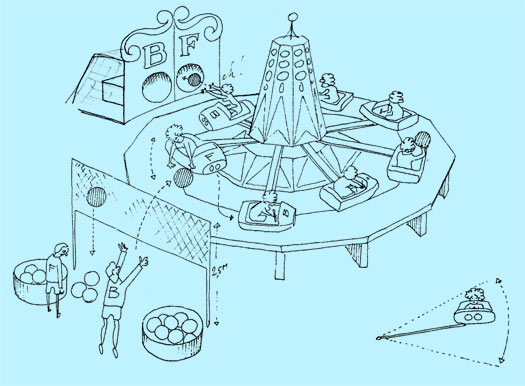 |
|
Image ©
BRT / VRT, 1975 |
| |
|
Running Scores and Positions:
1st Hoogvliet (NL) (12pts awarded / Joker
/ 18pts total)
2nd Knokke-Heist (B) (8pts / Joker / 12pts)
▲
3rd St. Ives (GB) (5pts / 7pts) ▲
4th Oppenheim (D) (--- / 5pts) ▼
=5th Neuilly-sur-Seine (F) (3pts / 4pts) ▲
=5th Cosenza (I) (1pt / 4pts) ▼
7th Riva San Vitale (CH) (3pts / 3pts) |
Game 3 - Het Hobbelpaard (The Rocking Horse)
3 boys. One player is riding a rocking horse pushed by 2
partners; he will have to throw over all figures in the proper sequence and in
the shortest possible time.
| |
|
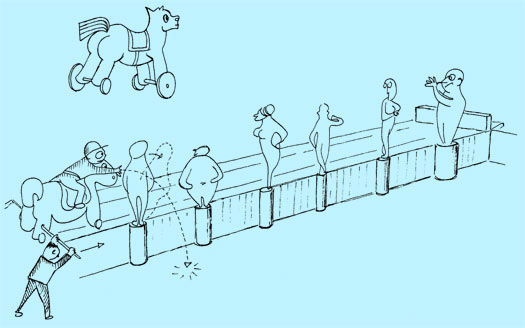 |
|
Image ©
BRT / VRT, 1975 |
| |
|
Running Scores and Positions:
1st Hoogvliet (NL) (1pt awarded / 19pts
total)
=2nd Knokke-Heist (B) (5pts / 17pts)
=2nd Oppenheim (D) (12pts / Joker / 17pts) ▲
4th St. Ives (GB) (6pts / Joker / 13pts) ▼
5th Riva San Vitale (CH) (5pts / 8pts) ▲
6th Cosenza (I) (2pts / 6pts) ▼
7th Neuilly-sur-Seine (F) (--- / 4pts) ▼ |
|
Comments:
Production paperwork shows that this
game was initially intended to run as the fourth game on the night, at
which time it was referred to as 'Horse Race'. By
the time of recording it had been changed to 'Het Hobbelpaard (The Rocking
Horse)' and had been redesignated as Game 3. |
Game 4 - De Getemde Beer (The Tamed Bear)
1 girl, 1 boy per team. One girl climbs the pole to get to the key to the cage
of the bear. With the key she hurries across the roller to release the bear,
whom she hooks to the safety strap. The bear is given a plate with 12 tins
which he must carry while balancing on the roller and progressing to the
finish line. The number of points is determined by the time required and the
number of tins left over.
| |
|
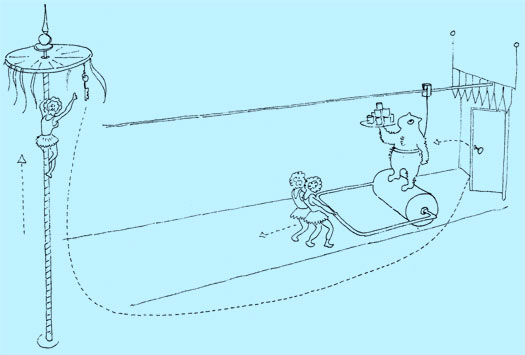 |
|
Image ©
BRT / VRT, 1975 |
| |
|
Running Scores and Positions:
1st Hoogvliet (NL) (5pts awarded / 24pts
total)
=2nd Knokke-Heist (B) (3pts / 20pts)
=2nd Riva San Vitale (CH) (12pts / Joker / 20pts) ▲
4th Oppenheim (D) (2pts / 19pts) ▼
5th St. Ives (GB) (--- / 13pts) ▼
=6th Neuilly-sur-Seine (F) (4pts / 8pts) ▲
=6th Cosenza (I) (2pts / 8pts) |
|
Comments:
Production paperwork suggests that this
game was initially intended to run as the second game on the night, at
which time it was referred to as 'Fighting the Bear'. It is not surprising
that the game was retitled as the description given beneath the first
title made no mention of the bear being involved in any conflict whatever!
By
the time of recording it had been changed to 'Taming the Bear' and had been moved to become Game
4. |
Game 5 - De Paardenmolen (The Roundabout)
2 girls and 2 boys per team. Boys sitting on the carousel
horses try catching water in buckets.
| |
|
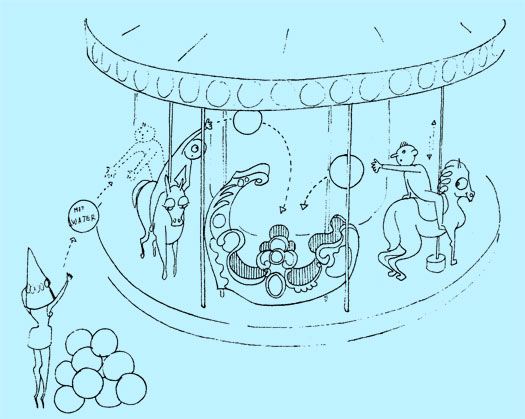 |
|
Image ©
BRT / VRT, 1975 |
| |
|
Running Scores and Positions:
1st Knokke-Heist (B) (6pts awarded / 26pts
total) ▲
2nd Hoogvliet (NL) (1pt / 25pts) ▼
=3rd Riva San Vitale (CH) (3pts / 23pts) ▼
=3rd Oppenheim (D) (4pts / 23pts) ▲
5th St. Ives (GB) (2pts / 15pts)
6th Neuilly-sur-Seine (F) (6pts / 14pts)
7th Cosenza (I) (--- / 8pts) ▼ |
|
Comments:
Production paperwork reveals that this
game was initially intended to run as the third game on the night, at
which time it was referred to as 'The Merry-Go-Round'. By
the time of recording it had been changed to 'De Paardenmolen (The
Roundabout)' - though this change could well be just one of translation
into English - and had been redesignated as Game 5. |
Game 6 - De Smoutbollen (The Fritters)
1 contestant per team has to catch as many fritters as possible
in a large basket.
| |
|
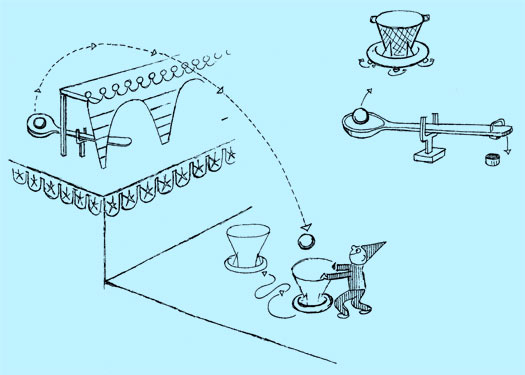 |
|
Image ©
BRT / VRT, 1975 |
| |
|
Running Scores and Positions:
1st Knokke-Heist (B) (5pts awarded / 31pts
total)
=2nd Riva San Vitale (CH) (4pts / 27pts) ▲
=2nd Oppenheim (D) (4pts / 27pts) ▲
4th Hoogvliet (NL) (--- / 25pts) ▼
5th Neuilly-sur-Seine (F) (6pts / 20pts) ▲
6th St. Ives (GB) (1pt / 16pts) ▼
7th Cosenza (I) (4pts / 12pts) |
|
Comments:
Production paperwork shows that this
game was initially intended to run as the fifth game on the night. By
the time of recording it had been redesignated as Game 6. |
Game 7 - Blikken Gooien (Tin Pitching)
1 boy per team. A contestant sits upon a metal chair which has been
installed on a conveyor belt. The chair will be moved slowly backwards (until it
stops above a pool and drops the contestant into it). This chair is equipped with a double bottom system. If
the contestant does not remain seated, then a fire-cracker will explode.
Facing the chair we have a series of tins set up in a booth. The contestant
will have to throw over as many tins as possible by means of balls picked up
left and right from the conveying belt.
| |
|
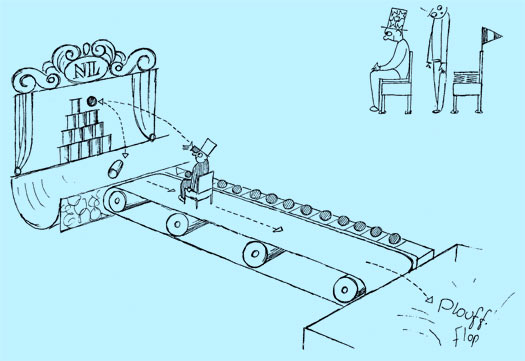 |
|
Image ©
BRT / VRT, 1975 |
| |
|
Running Scores and Positions:
=1st Knokke-Heist (B) (--- awarded / 31pts
total)
=1st Riva San Vitale (CH) (4pts / 31pts) ▲
=1st Oppenheim (D) (4pts / 31pts) ▲
4th Neuilly-sur-Seine (F) (10pts / Joker / 30pts) ▲
5th Hoogvliet (NL) (1pt / 26pts) ▼
6th St. Ives (GB) (6pts / 22pts)
7th Cosenza (I) (4pts / 16pts) |
|
Comments:
Production paperwork shows that this
game was initially intended to run as the sixth game on the night. By
the time of recording it had been redesignated as Game 7.
The original Game 7 - which was untitled in
the original games description booklet - required three male competitors
from each team to kick footballs from a narrow platform across a pool.
They would try to hit a circular target at the centre of two doors, hinged
to swing outwards - revealing the face of a clown, poking out his tongue -
each time the target was cleanly struck. When a revised games booklet was
issued, this game had been omitted and was replaced with a similar game -
'De Raket (The Net)' - which became Game 2. |
Fil Rouge - De Autoskooter (Scooter)
1 girl and 1 boy. 2 scooter cars per team try crushing as many
balloons as possible in the shortest time.
| |
|
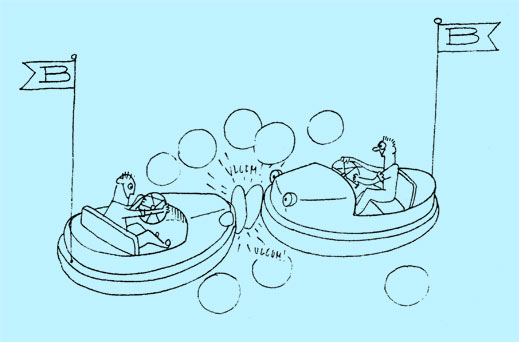 |
|
Image ©
BRT / VRT, 1975 |
| |
|
Final Fil Rouge Standings:
1st Knokke-Heist (B)
=2nd Oppenheim (D)
=2nd Cosenza (I)
=2nd Hoogvliet (NL)
=5th Riva San Vitale (CH)
=5th Neuilly-sur-Seine (F)
=5th St. Ives (GB) |
|
Running Scores and Positions:
1st Knokke-Heist (B) (7pts awarded / 38pts
total)
2nd Oppenheim (D) (6pts / 37pts) ▼
3rd Riva San Vitale (CH) (3pts / 34pts) ▼
4th Neuilly-sur-Seine (F) (3pts / 33pts)
5th Hoogvliet (NL) (6pts / 32pts)
6th St. Ives (GB) (3pts / 25pts)
7th Cosenza (I) (6pts / 22pts) |
Game 8 - De Sterke Man (The Strong Man)
1 girl and 1 boy per team. A sloping surface is coated with
sticky glue. A girl and a boy (blindfolded) of each team try getting to the
top. On their way, they have to crush five balloons. At the top of the platform,
the last to arrive will set off the fireworks signalling the end of the game.
| |
|
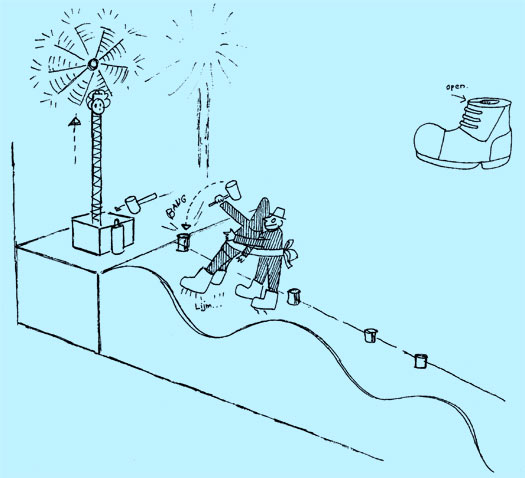 |
|
Image ©
BRT / VRT, 1975 |
| |
|
Final Scores and Positions:
1st Oppenheim (D) (6pts awarded / 43pts
total) ▲
2nd Knokke-Heist (B) (2pts / 40pts) ▼
3rd Hoogvliet (NL) (7pts / 39pts) ▲
4th Neuilly-sur-Seine (F) (5pts / 38pts)
5th Riva San Vitale (CH) (3pts / 37pts) ▼
6th St. Ives (GB) (4pts / 29pts)
7th Cosenza (I) (1pt / 23pts) |
|
Comments:
Production paperwork shows that this
game was altered in some important aspects in the days leading up to the
contest. The first games descriptions booklet distributed to production
and team personnel revealed the game as 'The Shooting Gallery' and, while
it featured the sticky slope with its balloons to burst, the task to be
performed at the top of the slope was to shoot pipe-bowls on a rotary
target. There was no strong man element, high striker to be hit with a
hammer, or fireworks to signal the end of the game. By the time a second
version of the games information booklet was issued, the game had been
renamed 'De Sterke Man (The Strong Man) and the shooting and target
elements had been set aside. |
|
|
Presenters, Officials and Production Team |
|
Following last year’s beige suit attire, the main referees’ outfits were
changed once again this year to beige jackets, light-blue trousers and white
floral shirts.
Throughout the history of Jeux Sans Frontières, the final placings of
each event were announced at the end of the programme by the local presenter.
This heat is unique in that respect, because rather than handing back to
presenter Mike Verdrengh, referee Gennaro Olivieri announced the scores of the
last game and then announced the placings himself: “The final results are -
Oppenheim with 43pts from Germany is the winner, Knokke-Heist from Belgium is
second with 40pts and third place is Hoogvliet from Holland with 39pts”. This
had never happened prior to this heat and has never been repeated since! |
|
Additional Information |
|
Game 2 - De Raket (The Net) - and Game 5 - ‘De Paardenmolen (The Roundabout)’ - as well as the Fil
Rouge - ‘De Autoskooter (Scooter)’ - all featured actual fairground rides. The Fil
Rouge involved a girl in a bumper car which had twenty balloons attached to
its rubber bumper, and three opposing team members had to drive against her
car and burst the balloons in the quickest time. One of the three team members
was the commentator from the country competing, who also had to commentate
whilst driving the bumper car! The competing commentators were: Ezio Guidi
(Switzerland), Erhard Keller (West Germany), Claude Savarit (France), Eddie
Waring (Great Britain), Giulio Marchetti (Italy), Barend Barendse
(Netherlands) and Marc van Poucke (Belgium). An interesting point to note was
that when Gennaro gave the score for Great Britain he referred to Eddie Waring
as ‘Uncle Eddie’ - a term which had been more commonly used by Stuart Hall to
describe his fellow commentator since 1972!
Throughout the programme, music from an authentic barrel-organ was played
whilst the games were played out, which clearly added to the fairground theme
and atmosphere.
This was the first time that an International Heat was staged before all the
British Domestic Heats had been recorded. A similar happening occurred in
1979, when the first two Internationals were held before completion of the
British Domestic series!
As from this heat onwards, BBC1 Wales began broadcasting the majority of
future International programmes on the following Sunday (or later), as opposed
to the rest of Great Britain.
The Belgian team of Knokke-Heist comprised of members from the towns and
villages of Albertstrand, Duinbergen, Heist-aan-Zee, Het Zoute and Knokke. |
|
Made
in Colour • This programme exists in the BBC Archives |
|
|
|
NL |
Jeux
Sans Frontières 1975 |
Heat
2 |
|
Event Staged: Tuesday 3rd June 1975
Venue:
Vrijthof van de Sint-Servaaskerk (St. Servatius Church Courtyard),
Maastricht, Netherlands
European Transmissions (Local Timings):
BRT (B): Tuesday 3rd June 1975, 9.05-10.20pm (Live)
RTB (B): Tuesday 3rd June 1975, 9.05-10.10pm (Live)
SRG (CH): Tuesday 3rd June 1975, 9.05-10.20pm (Live)
WDR 1 (D): Tuesday 3rd June 1975, 9.05-10.30pm (Live)
Nederland 1 (NL): Tuesday 3rd June 1975, 9.05-10.30pm (Live)
SSR (CH): Wednesday 4th June 1975, 8.15-9.35pm
TSI (CH): Wednesday 4th June 1975, 9.00-10.15pm
RAI Due (I): Wednesday 4th June 1975
RTP 2 (P): Tuesday 8th July 1975, 9.00-10.30pm
BBC1 (GB exc. Wales): Wednesday 3rd September 1975,
6.55-8.10pm
BBC1 Wales (CYM): Sunday 7th September 1975, 1.55-3.10pm
Winners' Trophy presented by: Fons Baeton, Mayor of
Maastricht |
|
Theme:
The Secret Service
|
|
Teams:
Rochefort (B) v. Zermatt (CH) v. Bietigheim-Bissingen (D) v.
Narbonne (F) v. Swansea (GB) v. Bracciano (I) v. Maastricht (NL) |
|
Team Members
included:
Rochefort (B) - Madeleine DeSoux;
Zermatt (CH) - Madeleine Calbert-Martin, Stefan Groenisch;
Bietigheim-Bissingen (D) - Rolf Schube (Team Coach), Hannelore
Grimm (Team Coach), Klaus Britsch, Inge Gleich, Günter Heinle, Karl-Heinz
Jablinski, Wolfgang Jogwer, Frieder Kling, Markus Kling, Bärbel Mack, Gerhard
Müller, Jürgen Ruof, Wolfgang Sinn, Ellen Tiedtke, Edeltraud Wachtler,
Christian Walter;
Narbonne (F) - Serge Denovak, Danielle Moganere, René Ray, Danielle
Roguemarrer;
Swansea (GB) - Alan Major (Team Trainer), Robert Sullivan (Team
Captain), J Alksanas, Jeff Buller, D Davies, Christine Griffiths, J Griffiths,
S Hayler, Susan Isaac, J Jones, Lee Jones, R Luke, A Mages, Chris Moore, Paul
Preedy, P Ronan, Robert Shaddick, Steve Seaman, William Sterio, G Sullivan,
Peter Thomas, Wendy Watson, Rose Williams, Mandy Wood, S Yeandle;
Bracciano (I) - Giovanni Bellini, Bruna Fronilli, Roberto
Irabetti;
Maastricht (NL) - Ad Daalmans (Team Coach), Gerard van der Hayden
(Team Captain), Jennifer Andersson, Nico Giunessen, Correy
Hermans. |
|
Games:
The Prison Break, The Plutonium Rod, The Private Island, Sherlock Holmes’ Dog,
Batman’s Outfit, The Brain-Washing Machine, James Bond and the Crocodiles and The
Aston Martin Race;
Fil Rouge: The Scientist's Robot;
Jokers: Country Maps overlaid with Flashing Sniper Targets. |
|
Game Results and Standings |
|
Games |
|
Team /
Colour |
1 |
2 |
3 |
4 |
5 |
6 |
7 |
FR |
8 |
Points Scored
(Joker games shown in red) |
|
B |
--- |
3 |
3 |
1 |
5 |
6 |
8 |
1 |
2 |
|
CH |
5 |
--- |
2 |
10 |
1 |
2 |
6 |
5 |
6 |
|
D |
4 |
5 |
--- |
3 |
4 |
4 |
12 |
7 |
7 |
|
F |
2 |
1 |
1 |
--- |
3 |
4 |
4 |
6 |
5 |
|
GB |
3 |
6 |
6 |
8 |
--- |
5 |
4 |
4 |
4 |
|
I |
6 |
4 |
5 |
12 |
2 |
--- |
1 |
2 |
1 |
|
NL |
1 |
2 |
8 |
2 |
6 |
1 |
--- |
3 |
3 |
Running Totals
(Leading teams shown in red) |
|
B |
0 |
3 |
6 |
7 |
12 |
18 |
26 |
27 |
29 |
|
CH |
5 |
5 |
7 |
17 |
18 |
20 |
26 |
31 |
37 |
|
D |
4 |
9 |
9 |
12 |
16 |
20 |
32 |
39 |
46 |
|
F |
2 |
3 |
4 |
4 |
7 |
11 |
15 |
21 |
26 |
|
GB |
3 |
9 |
15 |
23 |
23 |
28 |
32 |
36 |
40 |
|
I |
6 |
10 |
15 |
27 |
29 |
29 |
30 |
32 |
33 |
|
NL |
1 |
3 |
11 |
13 |
19 |
20 |
20 |
23 |
26 |
|
|
|
Result |
Team |
Points |
Final Scoreboard |
|
1st
2nd
3rd
4th
5th
=6th
=6th |
D •
Bietigheim-Bissingen
● ●
GB • Swansea ●
CH • Zermatt
I • Bracciano
B • Rochefort
F • Narbonne
NL • Maastricht |
46
40
37
33
29
26
26 |
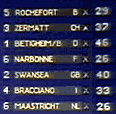 |
|
The Venue |
|
Maastricht, Netherlands
This heat was held in the historic vrijthof (courtyard) of St.
Servatius Church in Maastricht. The current courtyard square was built on the
area belonging to the St. Servatius Chapter, and served as a cemetery dating
back as far as the 5th century. During the Middle Ages, the cemetery was
covered over and was surrounded by houses which were occupied by canons in
attendance at the church. In 1972, the square began to subside and after
excavation a new car park was built underneath it. Nowadays, it is dominated
by the twin towers of St. Servatius Church and St. John, and is used for
festivals, fairs and outdoor concerts. |
|
The Games in Detail |
|
Game 1 - The Prison Break
|
Running Scores and Positions:
1st Bracciano (I) (6pts awarded / 6pts
total)
2nd Zermatt (CH) (5pts / 5pts)
3rd Bietigheim-Bissingen (D) (4pts / 4pts)
4th Swansea (GB) (3pts / 3pts)
5th Narbonne (F) (2pts / 2pts)
6th Maastricht (NL) (1pt / 1pt)
7th Rochefort (B) (--- / 0pts) |
Game 2 - The Plutonium Rod
|
Running Scores and Positions:
1st Bracciano (I) (4pts awarded / 10pts
total)
=2nd Bietigheim-Bissingen (D) (5pts / 9pts)
▲
=2nd Swansea (GB) (6pts / 9pts) ▲
4th Zermatt (CH) (--- / 5pts) ▼
=5th Rochefort (B) (3pts / 3pts) ▲
=5th Narbonne (F) (1pt / 3pts)
=5th Maastricht (NL) (2pts / 3pts) ▲ |
Game 3 - The Private Island
|
Running Scores and Positions:
=1st Swansea (GB) (6pts awarded / 15pts
total) ▲
=1st Bracciano (I) (5pts / 15pts)
3rd Maastricht (NL) (8pts / Joker / 11pts)
▲
4th Bietigheim-Bissingen (D) (--- / 9pts) ▼
5th Zermatt (CH) (2pts / 7pts) ▼
6th Rochefort (B) (3pts / 6pts) ▼
7th Narbonne (F) (1pt / 4pts) ▼ |
Game 4 - Sherlock Holmes' Dog
|
Running Scores and Positions:
1st Bracciano (I) (12pts awarded / Joker /
27pts total)
2nd Swansea (GB) (8pts / Joker / 23pts) ▼
3rd Zermatt (CH) (10pts / Joker / 17pts) ▲
4th Maastricht (NL) (2pts / 13pts) ▼
5th Bietigheim-Bissingen (D) (3pts / 12pts)
▼
6th Rochefort (B) (1pt / 7pts)
7th Narbonne (F) (--- / 4pts) |
Game 5 - Batman's Outfit
|
Running Scores and Positions:
1st Bracciano (I) (2pts awarded / 29pts
total)
2nd Swansea (GB) (--- / 23pts)
3rd Maastricht (NL) (6pts / 19pts) ▲
4th Zermatt (CH) (1pt / 18pts) ▼
5th Bietigheim-Bissingen (D) (4pts / 16pts)
6th Rochefort (B) (5pts / 12pts)
7th Narbonne (F) (3pts / 7pts) |
Game 6 - The Brain-Washing Machine
The sixth game -
‘The Brain-Washing Machine’ - required a female member of each team to have her
ears checked before competing to ensure that they were clear of any plugs or
blockages so that there was no possibility of her cheating. She was then seated in a
large chair and a pair of large ear-shaped headphones was placed over her
head, and then had to recite (in one of three languages - French, German or
Dutch) the famous French nursery song Frère Jacques:
“Frère Jacques, Frère Jacques,
Dormez-vous? Dormez-vous?
Sonnez les matines! Sonnez les matines!
Din, dan, don. Din, dan, don.”
After she had completed this, Guido blew the whistle and Gennaro pulled a
handle next to the chair. She then had to recite the song twice more, whilst
at the same time having her original recital replayed back through her ears at
different speeds and at a greater volume. Some of the girls concentrated hard
and were able to complete their recitals in fewer than 15 seconds. The Dutch
competitor completed the game in just 9 seconds, but loud jeers of disapproval
rang out around the square when Gennaro stated that she had missed out three
words from her recital and were penalised with a 15 second penalty (5 seconds
for each word). Anyone watching the heat would be asking the question “How
could you tell that they missed the words?”
|
Running Scores and Positions:
1st Bracciano (I) (--- awarded / 29pts
total)
2nd Swansea (GB) (5pts / 28pts)
=3rd Zermatt (CH) (2pts / 20pts) ▲
=3rd Bietigheim-Bissingen (D) (4pts / 20pts) ▲
=3rd Maastricht (NL) (1pt / 20pts)
6th Rochefort (B) (6pts / 18pts)
7th Narbonne (F) (4pts / 11pts) |
|
Comments:
The
Dutch television service NCRV once again provided a colourful and costumed
heat, and included a game which was hilarious to watch.
A version of this game would
later be played at Crystal Palace Football Ground in It's A Celebrity
Knockout 1976. |
Game 7 - James Bond and the Crocodiles
|
Running Scores and Positions:
=1st Bietigheim-Bissingen (D) (12pts
awarded / Joker / 32pts total) ▲
=1st Swansea (GB) (4pts / 32pts) ▲
3rd Bracciano (I) (1pt / 30pts) ▼
=4th Rochefort (B) (8pts / Joker / 26pts)
=4th Zermatt (CH) (6pts / 26pts) ▲
6th Maastricht (NL) (--- / 20pts) ▼
7th Narbonne (F) (4pts / 15pts) |
Fil Rouge - The Scientist's Robot
|
Final Fil Rouge Standings:
1st Bietigheim-Bissingen (D)
2nd Narbonne (F)
3rd Zermatt (CH)
4th Swansea (GB)
5th Maastricht (NL)
6th Bracciano (I)
7th Rochefort (B) |
|
Running Scores and Positions:
1st Bietigheim-Bissingen (D) (7pts awarded /
39pts total)
2nd Swansea (GB) (4pts / 36pts) ▼
3rd Bracciano (I) (2pts / 32pts)
4th Zermatt (CH) (5pts / 31pts)
5th Rochefort (B) (1pt / 27pts) ▼
6th Maastricht (NL) (3pts / 23pts)
7th Narbonne (F) (6pts / 21pts) |
Game 8 - The Aston Martin Race
|
Final Scores and Positions:
1st Bietigheim-Bissingen (D) (7pts awarded /
46pts total)
2nd Swansea (GB) (4pts / 40pts)
3rd Zermatt (CH) (6pts / 37pts) ▲
4th Bracciano (I) (1pt / 33pts) ▼
5th Rochefort (B) (2pts / 29pts)
=6th Narbonne (F) (5pts / 26pts) ▲
=6th Maastricht (NL) (3pts / 26pts) |
|
|
Presenters, Officials and Production Team |
|
At
the start of the programme, a space rocket was shown hanging in the sky which
then began to descend to earth, complete with landing flares ablaze. Inside
were referees Gennaro Olivieri and Guido Pancaldi. However, as the rocket
reached the arena floor and the referees were about to alight, presenter Dick
Passchier beckoned the two referees to remain in the rocket because the
introduction of the teams had not yet begun. After the teams had been
introduced, the camera once again panned to the rocket, which had now returned
to its original position in the sky. The rocket once again began to descend,
but this time without the landing flares, and the illusion was completed
shattered when arena lighting lit up the area and showed the hydraulic hoist
which was being used to lower the rocket! |
|
Returning Teams and Competitors |
|
Italian competitor Giovanni Bellini made the last of his nine appearances in
Jeux Sans Frontières at this heat. He had previously participated for
both of the Montecatini Terme teams in 1966 and 1967, Terracina in 1968,
Frascati in 1969 and Ancona in 1970. He made his final appearance as a member
of the Bracciano team in 1975. During his nine appearances, he assisted in
chalking up three victories (1966, 1967 and 1968) which also saw him competing
in the Semi-Finals (1966) and two International Finals (1967 and 1968), a 2nd
place (1969), an unfortunate 7th place (1970) and a 4th place at this heat. |
|
Additional Information |
|
This International Heat cost an estimated 250,000 Dutch guilders to stage.
Included in the cost was the construction of grandstands which had a 3,500
spectator capacity and reinforcement works to the underground parking lot
beneath the Maastricht Vrijthof square. This endeavour was considered
necessary in order to avoid possible collapse due to the weight of the games
and the water pools sited in the square above.
The
games were all based on fictional characters from spy novels and movies. The
Fil Rouge set included a large computer with dozens of dials and switches
(which were common in films featuring mad scientists), and the scoreboard was
built into this as the screen of the computer. The Jokers were cleverly
thought out and were some of the best seen over the programme’s history. Maps
of each individual country embossed with the national flags were overlaid
with a sniper’s target of four rings with a horizontal and vertical line
through the centre, together with a flashing central light.
The
scoreboard operators got a little ahead of themselves after Game 2. West
Germany and Great Britain took the first two positions on the game and were
awarded 6pts and 5pts, respectively, bringing both teams’ scores to 9pts. The
names of both teams began to flash to indicate that both teams were in first
place. However, the point’s score of the Italian team had not yet been awarded
and with them already having 6pts from the first game, Gennaro awarded them
4pts for finishing in third place bringing their total to 10pts. The British
team’s name immediately stopped flashing whilst the West German’s continued.
The Italian team’s name then began flashing and the West German’s finally
stopped!
During the West German team’s participation in the third Fil Rouge, two
Italian protesters invaded the game but were quickly removed by the Dutch
stagehands. Fortunately, the competitor was blind-folded and was unaware or
unable to see what had happened and was therefore judged not to have been
impeded by their actions. This was clearly obvious because the West German
team went on to win the Fil Rouge by a clear margin.
Although the West German team of Bietigheim-Bissingen won this heat by six
clear points, their performance was in complete contrast to the British and
Italian teams. Whilst Swansea and Bracciano had accumulated the majority of
their points in the first four games and then faltered at the end,
Bietigheim-Bissingen accumulated 26 pts of their 46 pts from the last two
games (Game 7 was with the Joker) and the Fil Rouge!
Portuguese broadcaster Rádio e Televisão de Portugal - RTP - appear to have
commenced screening Jeux Sans Frontières on their RTP 2 channel from this
heat. There is a possibility that the channel screened the first 1975
International Heat, but this is not recorded in television listings records.
The screenings would eventually lead to Portuguese participation in the
programme from 1979.
|
|
Made
in Colour • This programme exists in the BBC Archives
Exists in European archives |
|
|
|
I |
Jeux
Sans Frontières 1975 |
Heat
3 |
|
Event Staged: Tuesday 17th June 1975
Venue:
Piazzale Roma Spiaggia (Rome Square Beach),
Lungomare Repubblica (Republic Waterfront), Riccione, Italy
European Transmissions (Local Timings):
BRT (B): Tuesday 17th June 1975, 9.05-10.20pm (Live)
RTB (B): Tuesday 17th June 1975, 9.05-10.10pm (Live)
SSR (CH): Tuesday 17th June 1975, 9.05-10.25pm (Live)
SRG (CH): Tuesday 17th June 1975, 9.05-10.20pm (Live)
WDR 1 (D): Tuesday 17th June 1975, 9.05-10.30pm (Live)
Nederland 1 (NL): Tuesday 17th June 1975, 9.05-10.25pm (Live)
RAI Due (I): Tuesday 17th June 1975, 10.05-11.30pm (Live - DST)
TSI (CH): Wednesday 18th June 1975, 9.00-10.15pm
RTP 2 (P): Tuesday 22nd July 1975, 9.00-10.30pm
BBC1 (GB exc. Wales): Wednesday 10th September 1975,
6.55-8.10pm
BBC1 Wales (CYM): Sunday 14th September 1975, 1.55-3.10pm
Winners' Trophy presented by: Rosanna Vaudetti |
|
Theme:
Seaside Party |
|
Teams:
Mol (B) v. Le Mouret (CH) v. Attendorn (D) v.
Saint-Laurent-sur-Sèvre (F) v. Onchan (GB) v.
Riccione (I) v. Zwijndrecht (NL) |
|
Team Members
included:
Mol (B) - Paul Mavisse, Peter Toger, Renée van Grieken;
Le Mouret (CH) - Anne Deglise, Angel Endeckis;
Attendorn (D) - Yutte Baettig, Michael Droste, Helga Emmiss, Hieke Enginge, Josef
Hessel, Gertha Huntermann, Tagabert Schneider;
Saint-Laurent-sur-Sèvre (F) - Maurice Bressaint, Marie-Claire Segoine;
Onchan (GB) - Eddie Smith (Team Captain), William Christian, Linda Corkhill, Linda Court, Helen
Foster, Clifford Hamilton, John Horshouse, Brian Kane, Philip Kermode,
Karen Lees, Brian Mellor, Anne Moffatt, Helen Procter, Peter Quayle, Janice
Stubbs, Brian
Wasley;
Riccione (I) - Leopoldo Carlini (Co-Team Coach), Tiziano
Mulazzoni (Co-Team Coach), Franco Geminiani (Team Captain), Giuliana Amici,
Maria Luisa Balzelli, Giovanni Bezzi, Cecilia Bindelli, Luciano Caimi, Stefano
Carlini, Katya Cerri, Stefania Conti, Walter Corbelli, Daniela de Nittis,
Dario Dradi, Margherita Gasparini, Roberto Giannini, Federico Guardagli,
Fernanda Lanci, Dario Lorenzini, Renzo Magnani, Ugo Montevecchi, Davide Monti,
Gabriella Moretto, Giorgi Mulazzoni, Riccardo Mulazzoni,
Monica Mussoni, Pierluigi Pellizzola, Riccardo Proti, Leda Ricci, Santo Rossi, Vittorio
Servadio, Maurizio Sorci, Roberto Tontini, Maria Ugolini and Patrizia Vandi;
Zwijndrecht (NL) - Tom Bishop, Jan Cricifix, Carla Hawkins, Geert
Zijlmans. |
|
Games
(Official Titles): Il Ballo delle Seggiole (The Dance of the Chairs), Gara
di Canto con Votazione (Voting at a Singers Contest), Le Campane (The Bells),
Self Service (Self-Service), Limbo per i Camerieri (The Waiters' Limbo), Il
Topo Non Invitato (The Unwelcome Mouse), Le Reginette in Difficolta (Beauty
Queens in Trouble) and Finale (Final);
Fil Rouge: Non Sparate sull' Orchestra (Don't Shoot at the Orchestra);
Jokers: Seafaring Pleasure Craft. |
|
Game Results and Standings |
|
Games |
|
Team /
Colour |
1 |
2 |
3 |
4 |
5 |
6 |
7 |
FR |
8 |
Points Scored
(Joker games shown in red) |
|
B |
6 |
--- |
2 |
3 |
1 |
6 |
6 |
3 |
5 |
|
CH |
4 |
3 |
--- |
6 |
10 |
6 |
5 |
5 |
2 |
|
D |
1 |
6 |
6 |
--- |
3 |
2 |
1 |
6 |
6 |
|
F |
5 |
5 |
12 |
4 |
--- |
1 |
3 |
2 |
4 |
|
GB |
2 |
2 |
6 |
3 |
5 |
--- |
3 |
1 |
3 |
|
I |
3 |
6 |
6 |
5 |
2 |
6 |
--- |
7 |
7 |
|
NL |
--- |
4 |
3 |
1 |
12 |
6 |
4 |
4 |
1 |
Running Totals
(Leading teams shown in red) |
|
B |
6 |
6 |
8 |
11 |
12 |
18 |
24 |
27 |
32 |
|
CH |
4 |
7 |
7 |
13 |
23 |
29 |
34 |
39 |
41 |
|
D |
1 |
7 |
13 |
13 |
16 |
18 |
19 |
25 |
31 |
|
F |
5 |
10 |
22 |
26 |
26 |
27 |
30 |
32 |
36 |
|
GB |
2 |
4 |
10 |
13 |
18 |
18 |
21 |
22 |
25 |
|
I |
3 |
9 |
15 |
20 |
22 |
28 |
28 |
35 |
42 |
|
NL |
0 |
4 |
7 |
8 |
20 |
26 |
30 |
34 |
35 |
|
|
|
Result |
Team |
Points |
Final Scoreboard |
|
1st
2nd
3rd
4th
5th
6th
7th |
I •
Riccione
● ●
CH • Le Mouret
F • Saint-Laurent-sur-Sèvre
NL • Zwijndrecht
B • Mol
D • Attendorn
GB • Onchan |
42
41
36
35
32
31
25 |
 |
|
The Host
Town |
|
Riccione, Italy
Riccione is a town and holiday resort with a permanent
population of around 36,000 inhabitants. It is located 115km (71½ miles) east
of Firenze, 163km (101¼ miles) south of Venezia, 234km (145½ miles) north of
Roma and 319km (198¼ miles) south-east of Milano. Riccione is on the Adriatic
coast in the Italian region of Emilia-Romagna, famous for exporting food all
over the world e.g. Parmesan cheese, Parma ham and Ragu Bolognese.
The area around Riccione dates back to the 2nd century BC,
although it was most likely that settlements had appeared earlier. At the time
of the Roman Republic, it was known as Vicus Popilius and after a period of
obscurity, it was acquired by the Agolanti family in 1260, which was connected
to the lords of Rimini, the Malatesta. During the 17th century, watchtowers
were built along the coast in order to prevent attack from pirates.
Origins of the tourist fame of Riccione date to the late 19th
century, mostly spurred by the construction of residences by rich Bolognese
people. In the 1930s, the resort attracted around 30,000 tourists a year and
had around 80 existing hotels. It gained the status of a main destination of
summer tourism on the Adriatic Riviera of Romagna. After World War II
(1939-1945), tourism was further increased after it became a chosen vacation
resort of numerous famous people, such as Brazilian footballer Pelè (Edson
Arantes do Nascimento) and a variety of Italian celebrities including singer
Mina Mazzini, film director Vittorio de Sica (1901-1974), film actor and
director Ugo Tognazzi (1922-1990) and Maria Scicolone (younger sister of
actor Sophia Loren).
Today, tourism in Riccione is massive and, together with
Rimini, it is one of the best known and largest seaside resorts in Northern
Italy. The Adriatic coast of Emilia-Romagna is called Riviera Romagnola and
has plenty of night clubs and is therefore very attractive to young adults.
However, Riccione is also family-friendly, thanks to its hotels that offer
baby-sitting facilities all day in the hotel and on the beach and the nearby
theme parks. The main streets of Riccione, Viale Dante and Viale Ceccarini,
although having numerous hotels, nightclubs and bars, are also the best places
for shopping and eating during the day. The seafront is a long boulevard
comprised of a wide cycle lane with a pedestrian only walkway on either side
and is decked out with numerous flower beds, green areas, plants and wooden
benches for resting. Along parts of the promenade, there is no longer any road
between the hotels and the beach and cars are subjected to going underground
to car parks which are open 24 hours a day.
Along with the miles of golden sands and the nightlife, the
main sights on offer include the ancient Roman Ponte di Tiberio (Tiberio
Bridge) dating to AD 20 and Villa Mussolini (originally called Villa
Margherita when it was constructed in 1890), the holiday home of Benito
Mussolini (1883-1945) which he purchased in 1934. Used as a summer retreat by
his family, the Villa Mussolini is now used by the town of Riccione for
exhibitions and other events. |
|
The Venue |
|
Piazzale Roma Spiaggia
The games were played on the beautiful golden sands and
seafront of Riccione’s Piazzala Roma beach which form part of a 66km (41
miles) long, unbroken stretch of beach running from Lido di Savio in the north
to Cattolica in the south, taking in the resorts of Cesenatico, Bellaria,
Rimini, Misano Adriatico and Riccione. At the height of the summer vacation
season, the beaches are teeming with sunseekers and tourists. As is such, for
safety and security measures, the colossal stretch of sands are split in 151
bathing-stations or sections and individually numbered with Riccione’s Roma
Beach starting at 66 and running through to 85. There are a total of 41
lifeguard towers, all highly visible, with an intercom system connected to all
the bathing-stations and there are special pet-friendly beaches at numbers 32,
122 and 138. The whole coastline from the waterline up to the hotels is mapped
out with military precision. Closest to the water’s edge are nine rows of
deck-chairs, sun-loungers and umbrellas. Moving backwards and towards the town
are the chalets / lockers, relaxation areas and small children’s pools. These
are followed by a row which includes lifeguard lookouts (known as casa
bagninos), bicycles parking areas and public showers. After this come the
beach sports areas entertaining beach volleyball and football etc. After these
comes the lungomare (or promenade) and finally the hotels.
Every two years, the most recent being in 2014, the town plays host to the
Festival del Sole, the largest international ‘gymnastics for all’ exhibition
in the Mediterranean area. For a whole week, the seafront is turned into a
huge stage where more than 4,000 athletes from around the world perform at
their best. Floor exercises and aerobics, acrogym and acrobatics, rhythmic and
artistic gymnastic, classical and modern dance, hip-hop and funky are a few of
the forms of gymnastics and dances taking place at the festival. There are no
limits regarding age or ability and anyone with the desire to perform in front
of a large audience in one of the four arenas on the seafront can join the
festival. There are no judges or points awarded and the only winner is the
pleasure of being together and practicing sport.
This same
beach-side venue had been used previously for the Italian International heat
in 1971. In addition to these two visits to Riccione, the only other on-beach
locations in the programme’s history were Senigallia in 1973 (again on Italy's
Adriatic coast), and Grömitz in West Germany in 1978. |
|
The Games
in Detail |
|
Game 1 - Il Ballo delle Seggiole (The Dance of the Chairs)
1 boy per team. Contestants are tied hands and feet to a stuffed doll
featuring a tall fat partner. The game is an elimination contest. After a
while of dancing, upon a signal from a judge, contestants will climb up onto a
tall stool, taking care never to turn the partner's back to the TV cameras.
| |
|
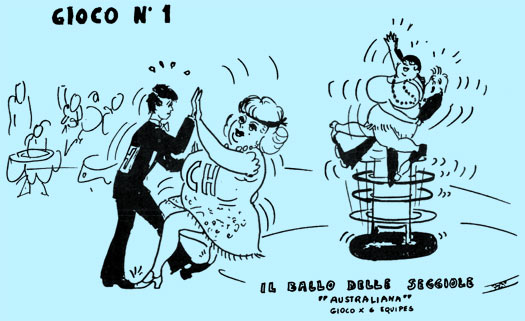 |
|
Image © RAI,
1975 |
| |
|
Running Scores and Positions:
1st Mol (B) (6pts awarded / 6pts total)
2nd Saint-Laurent-sur-Sèvre (F) (5pts / 5pts)
3rd Le Mouret (CH) (4pts / 4pts)
4th Riccione (I) (3pts / 3pts)
5th Onchan (GB) (2pts / 2pts)
6th Attendorn (D) (1pt / 1pt)
7th Zwijndrecht (NL) (--- / 0pts) |
Game 2 - Gara di Canto con Votazione (Voting at a Singers Contest)
3 girls and 4 boys. The purpose of the game is to secure the
singer of the contestant's own team with the largest possible number of valid
votes. The valid votes consist of sheets bearing stamped-on numbers from 'ONE'
to 'SIX'. No trials of the game will be performed with all the items available
to the players (paper, stamps, ink-pad). The game is played in six successive
heats using a moving belt, the travelling speed of which will be related to
the intensity of the "sham singer's" voice.
| |
|
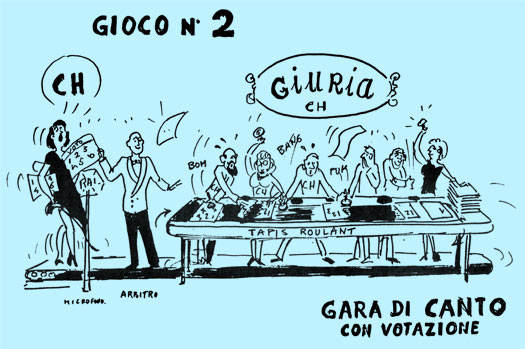 |
|
Image © RAI,
1975 |
| |
This game was very funny
although it was not designed as such. It involved seven members of each team
standing at 90° to the movement of travel on a conveyor belt which moved at a
set speed. On the whistle, the conveyor belt began to move and six of the team
members had to stamp invitation cards whilst stepping in the opposite
direction to that of the belt. In order to slow the conveyor belt, the seventh
team member, a female, had to sing anything she wanted at a very loud volume
which was indicated on a lighted column next to her. If her voice quietened,
the lights decreased and the belt’s speed increased. This game was clearly
meant for the Italians with their love of singing and opera, and the team
finished the game with 6 pts after stamping eighteen invitation cards
correctly. The West German team of Attendorn and the British team from Onchan
had both decided to play their Jokers on this game, and both ended up becoming
a cropper. Whilst the Attendorn team stamped eleven invitations and scored
just 6 pts on their Joker, the Onchan team finished bottom of the pile,
stamping just four correctly and scoring just 2 pts!
|
Running Scores and Positions:
1st Saint-Laurent-sur-Sèvre (F) (5pts
awarded / 10pts total) ▲
2nd Riccione (I) (6pts / 9pts) ▲
=3rd Le Mouret (CH) (3pts / 7pts)
=3rd Attendorn (D) (6pts / 7pts) ▲
5th Mol (B) (--- / 6pts) ▼
=6th Onchan (GB) (2pts / Joker / 4pts) ▼
=6th Zwijndrecht (NL) (--- / 4pts) ▲ |
Game 3 - Le Campane (The Bells)
1 boy. A player will have to play the song O Sole Mio on
the top of a flexible pole. He will be assisted by numbers which correspond to
the bells, so that even if he does not know music, he can still play the game.
The winner will be the one who plays the piece in the shortest time.
| |
|
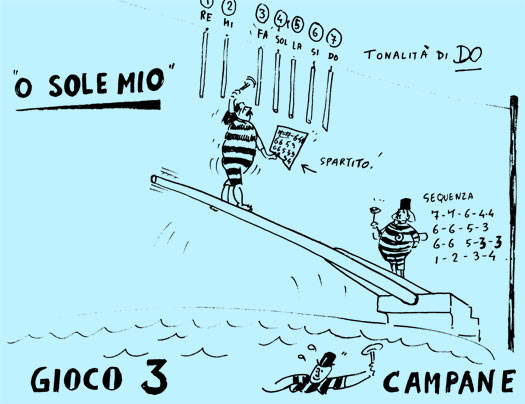 |
|
Image ©
RAI, 1975 |
| |
|
Running Scores and Positions:
1st Saint-Laurent-sur-Sèvre (F) (12pts
awarded / Joker / 22pts total)
2nd Riccione (I) (6pts / Joker / 15pts)
3rd Attendorn (D) (6pts / 13pts)
4th Onchan (GB) (6pts / 10pts) ▲
5th Mol (B) (2pts / Joker / 8pts)
=6th Le Mouret (CH) (--- / 7pts) ▼
=6th Zwijndrecht (NL) (3pts / 7pts) |
Game 4 - Self Service (Self-Service)
1 girl, 2 boys per team. By operating a special table through foot controls
every team is to collect 18 cakes that will drop from above onto a fixed point
of the platform. Since it is impossible to store the 18 pieces on the table,
every team will have an appropriate storing space and a container of its own,
at the border of the game floor. When the pieces collected in the container
reach the number of 18, the team will run from the game floor down to the
finish which will be located at the bottom of a fairly impressive descent.
| |
|
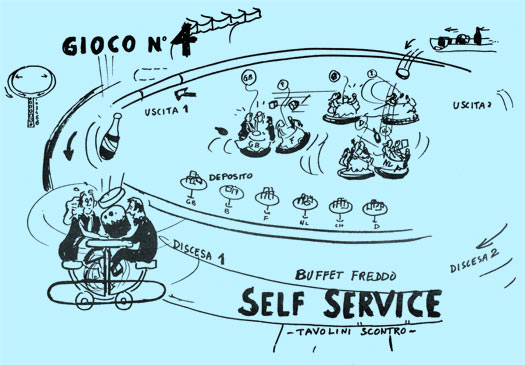 |
|
Image ©
RAI, 1975 |
| |
|
Running Scores and Positions:
1st Saint-Laurent-sur-Sèvre (F) (4pts
awarded / 26pts total)
2nd Riccione (I) (5pts / 20pts)
=3rd Le Mouret (CH) (6pts / 13pts) ▲
=3rd Attendorn (D) (--- / 13pts)
=3rd Onchan (GB) (3pts / 13pts) ▲
6th Mol (B) (3pts / 11pts) ▼
7th Zwijndrecht (NL) (1pt / 8pts) ▼ |
Game 5 - Limbo per i Camerieri (The Waiters' Limbo)
1 boy per team. Every contestant is to pass below a bar which
will be set ever lower at every turn. If the contestant causes the bar to drop
or if he falls into the swimming pool he is eliminated from the game.
| |
|
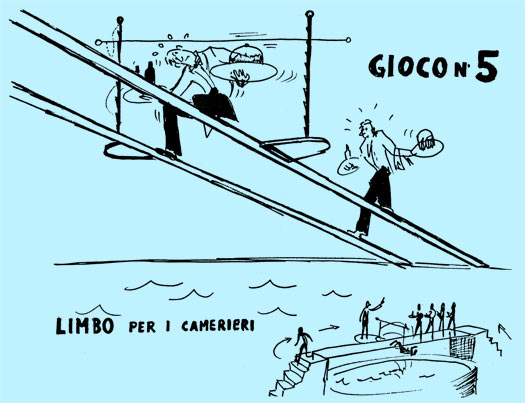 |
|
Image ©
RAI, 1975 |
| |
|
Running Scores and Positions:
1st Saint-Laurent-sur-Sèvre (F) (---
awarded / 26pts total)
2nd Le Mouret (CH) (10pts / Joker / 23pts) ▲
3rd Riccione (I) (2pts / 22pts) ▼
4th Zwijndrecht (NL) (12pts / Joker / 20pts)
▲
5th Onchan (GB) (5pts / 18pts) ▼
6th Attendorn (D) (3pts / 16pts) ▼
7th Mol (B) (1pt / 12pts) ▼ |
Game 6 - Il Topo Non Invitato (The Unwelcome Mouse)
1 girl, 2 boys per team. The platform is divided into 6
sectors. Every team will endeavour to drive out of its own sector a mouse
which will be actioned by a firework. The firework will last any length of
time between 10 and 20 seconds, with some lasting longer than others. The
mouse actioned by the firework will suddenly stop in a burst. The sector in
which the burst occurs is to get one point of penalty.
| |
|
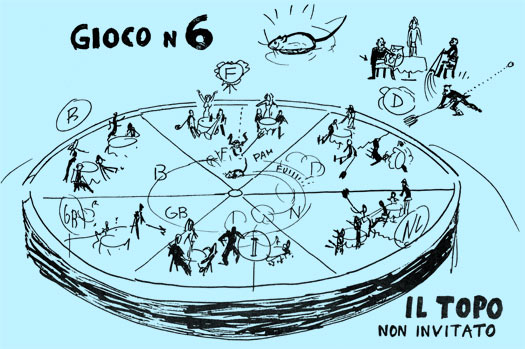 |
|
Image ©
RAI, 1975 |
| |
|
Running Scores and Positions:
1st Le Mouret (CH) (6pts awarded / 29pts
total) ▲
2nd Riccione (I) (6pts / 28pts) ▲
3rd Saint-Laurent-sur-Sèvre (F) (1pt / 27pts)
▼
4th Zwijndrecht (NL) (6pts / 26pts)
=5th Mol (B) (6pts / 18pts) ▲
=5th Attendorn (D) (2pts / 18pts) ▲
=5th Onchan (GB) (--- / 18pts) |
Game 7 - Le Reginette in Difficolta (Beauty Queens in Trouble)
1 girl, 2 boys per team. Beauty queens must stay erect on a
roller which at first is motionless and later starts rotating, faster and
faster. Two partners will try and help her using a giant streamer which they
launch and wind tight around the girl. The score is based on the length of
time the contestants resist on the roller.
| |
|
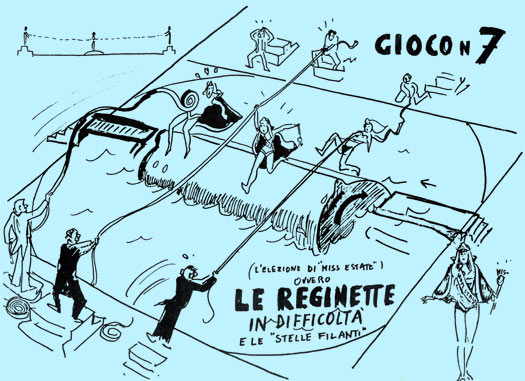 |
|
Image ©
RAI, 1975 |
| |
|
Running Scores and Positions:
1st Le Mouret (CH) (5pts awarded / 34pts
total)
=2nd Saint-Laurent-sur-Sèvre (F) (3pts / 30pts) ▲
=2nd Zwijndrecht (NL) (4pts / 30pts) ▲
4th Riccione (I) (--- / 28pts) ▼
5th Mol (B) (6pts / 24pts)
6th Onchan (GB) (3pts / 21pts) ▼
7th Attendorn (D) (1pt / 19pts) ▼ |
Fil Rouge - Non Sparate sull' Orchestra (Don't Shoot at the Orchestra)
2 girls and 4 boys. The purpose of the game is to resist the
longest possible time on a special platform which pivots slowly to a
precarious angle. A team of opponents will seek to disturb the orchestra by
throwing large water-filled balloons. A timekeeper will check individually
each contestant. Timekeepers will take the exact time at which every single
contestant hits the water in the pool at the base of the platform. The total
time of the team will be the sum total of the partial times taken.
| |
|
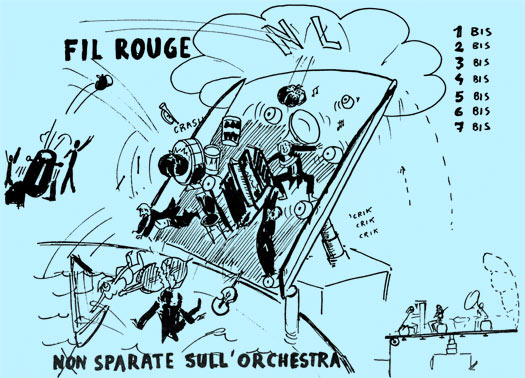 |
|
Image © RAI,
1975 |
| |
The Fil Rouge involved six members of each team
with life-size musical instruments on a platform which protruded over a pool
and which had three large cone-shaped upright bollards atop it. On the
whistle, the rear of the platform gradually ascended resulting in the front
descending, but the teams had to remain in their original positions whilst
opposing team members fired large water-filled balloons on to the platform
from a giant catapult to displace them. After 30 seconds, a second whistle was
sounded, and this signalled that any remaining players could then move and
best position themselves to cling to the platform as it continued to be
lowered to its maximum 90° angle. Obviously, it was better for the players to
get to the protruding bollards because they were now at an advantageous angle
to sit behind or cling on to, but they had to be careful as the bollards had
revolving outside covers. Dutch team Zwijndrecht went first and two of their
members managed to stay on the platform for 90 seconds (maximum time limit),
by cleverly sitting behind one of the bollards at a complete 90° angle to it
and then holding firm. All the times of the six members were individually
taken as they fell off and then added together to ascertain a total time, with
the maximum score being a total of 540 seconds (6 x 90).
Thirty-two seconds into the Swiss participation on the Fil Rouge, Gennaro
Olivieri blew the whistle to stop the game and the platform stopped
descending. He then told the Swiss competitor holding the cello that he should
have been standing further forward onto the mark at the front of the platform.
At that point, one of the Swiss competitors slid off the platform and into the
pool below. The platform was then lifted back into its original position and
there was a slight pause whilst the Swiss competitor climbed back up to the
platform and re-positioned himself.
|
Final Fil Rouge Standings:
1st Riccione (I)
2nd Attendorn (D)
3rd Le Mouret (CH)
4th Zwijndrecht (NL)
5th Mol (B)
6th Saint-Laurent-sur-Sèvre (F)
7th Onchan (GB) |
|
Running Scores and Positions:
1st Le Mouret (CH) (5pts awarded / 39pts
total)
2nd Riccione (I) (7pts / 35pts) ▲
3rd Zwijndrecht (NL) (4pts / 34pts) ▼
4th Saint-Laurent-sur-Sèvre (F) (2pts / 32pts)
▼
5th Mol (B) (3pts / 27pts)
6th Attendorn (D) (6pts / 25pts) ▲
7th Onchan (GB) (1pt / 22pts) ▼ |
Game 8 - Finale (Final)
1 girl and 1 boy per team. The couple is tied back to back with
a safety belt. The area is entirely covered by balloons of different colours.
The couple must chose the red ones, and throw five of them in the Champagne
cup, only using their feet.
| |
|
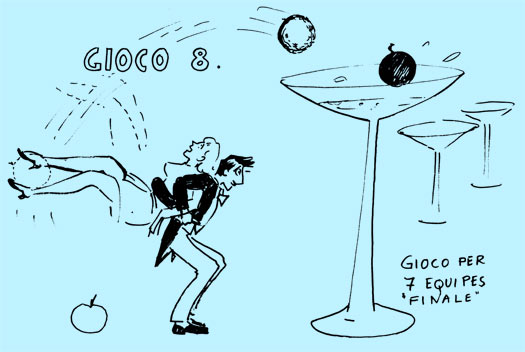 |
|
Image ©
RAI, 1975 |
| |
|
Final Scores and Positions:
1st Riccione (I) (7pts awarded / 42pts
total) ▲
2nd Le Mouret (CH) (2pts / 41pts) ▼
3rd Saint-Laurent-sur-Sèvre (F) (4pts / 36pts) ▲
4th Zwijndrecht (NL) (1pt / 35pts) ▼
5th Mol (B) (5pts / 32pts)
6th Attendorn (D) (6pts / 31pts)
7th Onchan (GB) (3pts / 25pts) |
|
|
Team
Personnel |
|
One of the Riccione team members was former Italian basketball player Santo Rossi,
who was born in nearby Fruili on 7th March 1940. He had arrived at Unione
Sportiva Victoria Libertas Pallacanestro (known locally as Vuelle or VL) in
1969, after having played at Virtus Bologna and later in Forlì. On his arrival
at Pesaro, he was trained for the next four seasons by coach Boris Sinkovic.
Rossi continued to play at Pesaro until his retirement from the
game after the 1973-74 season and along the way was chosen to wear the
national team shirt on seventeen occasions. He had also won a gold medal at
the Mediterranean games staged at Naples in 1963.
Rossi, standing at 2.12m (6ft 11½in) tall, had a real passion for basketball,
which he also passed on to his children - Giulio grew up in the youth of
Victoria Libertas and then Francesca who had a brilliant career in the top
women's championship.
On 31st March 2020, it was announced in local newspaper Il Resto del
Carlino (Pesaro) that Rossi had succumbed to Coronavirus and had died, 24
days after celebrating his 80th birthday. |
|
Returning Teams and Competitors |
|
Italian team members Franco Geminiani, Gabriella Moretto, Santo Rossi,
Maurizio Sorci and co-team coach Tiziano Mulazzoni had all participated
previously for Riccione in 1971, whilst Maria Luisa Balzelli and Vittorio
Servadio had been members of the Città di Castello team in 1972. Co-team coach
Leopoldo Carlini had also participated as a team member for Riccione in 1971,
and also returned to the team coach role for the Rimini e Adriatico team in
1988. Margherita Gasparini, Franco Geminiani and Ugo Montevecchi all returned
as team members for Rimini e Adriatico in 1988. |
|
Additional Information |
|
The West German transmission for this programme was hit with a total loss
of communication from the two presenters for the first 25 minutes of the
broadcast. Although the programme was broadcast with a subdued live Italian
commentary, it was not until after 10 minutes that the ARD-WDR continuity
announcer apologised for the loss of sound, due to the audio link from
Riccione being lost. After a further 5 minutes, a second apology was broadcast
followed by a visual on-screen message three minutes later. The message simply
stated ‘Die Deutsche Kommentarleitung ist Leider Unterbrochen’. This was then
followed about two minutes later with another verbal apology and with the
message ‘Die Deutsche Kommentarleitung von Italien ist Leider Unterbrochen.
Wir Bitten um Geduld’. (The German commentary from Italy is unfortunately
interrupted. Please be patient). The programme then continued with the actual
live Italian commentary until the West German commentators Erhard Keller and
Karl-Heinz Wocker finally introduced themselves to the viewing audience during
the closing heats of the second game.
It was a totally different story for British team Onchan on the Fil Rouge
compared to every other team. The team had been highly fancied to win this
heat, but it had been a night of one disaster after another and even on the
Fil Rouge, things did not improve. Even before the second whistle had sounded,
the team had lost four of their members to the pool below and with the worst
total combined time of 258 seconds for all six players, the team ended up in
seventh position on the Fil Rouge as well as on the night as a whole. However
on a lighter note, each of the Fils Rouge was played out against a tune
representative of the country competing by the local jazz band. The
Netherlands tune was appropriately ‘Tulips from Amsterdam’ whilst Great
Britain played the Fil Rouge to the strains of ‘Auld Lang Syne’! Incidentally,
this game was copied for the Italian International Final in 1982 and re-copied
for the International heat held at Villa Manin in Passariano di Codroipo, Italy in 1993,
although the incline on that occasion was less severe.
The Swiss team of Le Mouret lost this heat rather than the Italians winning
it. Riccione had not led the competition once the whole night, and the team
could only manage to score 6pts on their Joker. Trailing the Swiss team by
4pts before the last game, the team won it in fine style, as they had Game 6
and the Fil Rouge. The Swiss team however only needed 3pts to secure the win
but unfortunately could only muster 2pts on the game and handed the heat to
the Italians.
Onchan became the first team from the Isle of Man to
represent Great Britain in Jeux Sans Frontières. |
|
Made
in Colour • This programme exists in the BBC Archives
Exists in European archives |
|
|
|
CH |
Jeux
Sans Frontières 1975 |
Heat
4 |
|
Event Staged: Tuesday 1st July 1975
Venue:
Klosterhof (Monastery Square), Engelberg, Switzerland
European Transmissions (Local Timings):
BRT (B): Tuesday 1st July 1975, 9.05-10.20pm (Live)
RTB (B): Tuesday 1st July 1975, 9.05-10.10pm (Live)
SSR (CH): Tuesday 1st July 1975, 9.05-10.25pm (Live)
SRG (CH): Tuesday 1st July 1975, 9.05-10.20pm (Live)
WDR 1 (D): Tuesday 1st July 1975, 9.05-10.30pm (Live)
Nederland 2 (NL): Tuesday 1st July 1975, 9.05-10.25pm (Live)
RAI Due (I): Tuesday 1st July 1975, 10.05-11.30pm (Live - DST)
TSI (CH): Wednesday 2nd July 1975, 9.00-10.15pm
RTP 2 (P): Tuesday 5th August 1975, 10.00-11.30pm
BBC1 (GB exc. Wales): Wednesday 17th September 1975,
6.55-8.10pm
BBC1 Wales (CYM): Sunday 21st September 1975, 1.55-3.10pm
Winners' Trophy presented by: Jan Hiermeyer |
|
Theme:
Holidays in the Mountains |
|
Teams:
Pepinster (B) v. Giswil (CH) v. Leonberg (D) v. Chartres (F) v.
Darlington (GB) v. Aosta (I) v. Veldhoven (NL) |
|
Team Members
included:
Pepinster (B) - Christian Marquette;
Leonberg (D) - Franz Evets, Annette Negen;
Darlington (GB) - Malcolm Stringer (Team Captain), Douglas
Beddelson, James Branchorne, John Brockbanks, Margaret Davison, Helen Drew,
Stanley Garside, Jeffrey Graham, Frank Johnson, Janet McKean, Kay Metcalfe,
Eddie Stock, David Stott, Nancy Warwick;
Aosta (I) - Nadina Catriana. |
|
Games:
Dressing the Snowmen, Bales of Hay and Tourists, Cows and Mushrooms, Catching
Butterflies, The Milk Churns, Collecting Edelweiss, The Haystack and The Skiing Tourists;
Fil Rouge: The Hungry Bears;
Jokers: Alpine Horns, which had to be played. |
|
Game Results and Standings |
|
Games |
|
Team /
Colour |
1 |
2 |
3 |
4 |
5 |
6 |
7 |
FR |
8 |
Points Scored
(Joker games shown in red) |
|
B |
6 |
1 |
1 |
1 |
3 |
--- |
6 |
3 |
3 |
|
CH |
5 |
3 |
6 |
1 |
3 |
12 |
--- |
2 |
1 |
|
D |
--- |
6 |
8 |
5 |
6 |
3 |
1 |
7 |
5 |
|
F |
4 |
--- |
3 |
5 |
3 |
10 |
1 |
6 |
6 |
|
GB |
4 |
5 |
--- |
6 |
4 |
1 |
5 |
4 |
2 |
|
I |
6 |
1 |
2 |
--- |
6 |
4 |
1 |
6 |
7 |
|
NL |
2 |
8 |
5 |
5 |
--- |
4 |
1 |
1 |
4 |
Running Totals
(Leading teams shown in red) |
|
B |
6 |
7 |
8 |
9 |
12 |
12 |
18 |
21 |
24 |
|
CH |
5 |
8 |
14 |
15 |
18 |
30 |
30 |
32 |
33 |
|
D |
0 |
6 |
14 |
19 |
25 |
28 |
29 |
36 |
41 |
|
F |
4 |
4 |
7 |
12 |
15 |
25 |
26 |
32 |
38 |
|
GB |
4 |
9 |
9 |
15 |
19 |
20 |
25 |
29 |
31 |
|
I |
6 |
7 |
9 |
9 |
15 |
19 |
20 |
26 |
33 |
|
NL |
2 |
10 |
15 |
20 |
20 |
24 |
25 |
26 |
30 |
|
|
|
Result |
Team |
Points |
Final Scoreboard |
|
1st
2nd
=3rd
=3rd
5th
6th
7th |
D
• Leonberg
●
F • Chartres
CH • Giswil
I • Aosta
GB • Darlington
NL • Veldhoven
B • Pepinster |
41
38
33
33
31
30
24 |
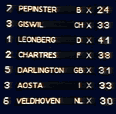 |
|
The Venue |
|
Engelberg, Switzerland
This heat
in Engelberg was held in the Monastery Square which is surrounded on the
western side by the Gemeindehaus (Community House) and is overlooked on the
eastern side by the beautiful Engelberg Abbey, a Benedictine monastery founded
in 1120 by Blessed Conrad, Count of Seldenburen. Although the location was
picturesque, the weather dampened things somewhat, and for the second year in
succession, the Swiss heat was witness to heavy rain throughout, hampering the
competitors on the games. |
|
The Games in Detail |
|
Game 1 - Dressing the Snowmen
|
Running Scores and Positions:
=1st Pepinster (B) (6pts awarded / Joker / 6pts
total)
=1st Aosta (I) (6pts / 6pts)
3rd Giswil (CH) (5pts / 5pts)
=4th Chartres (F) (4pts / 4pts)
=4th Darlington (GB) (4pts / Joker / 4pts)
6th Veldhoven (NL) (2pts / 2pts)
7th Leonberg (D) (--- / 0pts) |
Game 2 - Bales of Hay and Tourists
|
Running Scores and Positions:
1st Veldhoven (NL) (8pts awarded / Joker /
10pts total) ▲
2nd Darlington (GB) (5pts / 9pts) ▲
3rd Giswil (CH) (3pts / 8pts)
=4th Pepinster (B) (1pt / 7pts) ▼
=4th Aosta (I) (1pt / 7pts) ▼
6th Leonberg (D) (6pts / 6pts) ▲
7th Chartres (F) (--- / 4pts) ▼ |
Game 3 - Cows and Mushrooms
|
Running Scores and Positions:
1st Veldhoven (NL) (5pts awarded / 15pts
total)
=2nd Giswil (CH) (6pts / 14pts) ▲
=2nd Leonberg (D) (8pts / Joker / 14pts) ▲
=4th Darlington (GB) (--- / 9pts) ▼
=4th Aosta (I) (2pts / 9pts)
6th Pepinster (B) (1pt / 8pts) ▼
7th Chartres (F) (3pts / 7pts) ▼ |
Game 4 - Catching Butterflies
|
Running Scores and Positions:
1st Veldhoven (NL) (5pts awarded / 20pts
total)
2nd Leonberg (D) (5pts / 19pts)
=3rd Giswil (CH) (1pt / 15pts) ▼
=3rd Darlington (GB) (6pts / 15pts) ▲
5th Chartres (F) (5pts / 12pts) ▲
=6th Pepinster (B) (1pt / 9pts)
=6th Aosta (I) (--- / 9pts) ▼ |
Game 5 - The Milk Churns
|
Running Scores and Positions:
1st Leonberg (D) (6pts awarded / 25pts
total) ▲
2nd Veldhoven (NL) (--- / 20pts) ▼
3rd Darlington (GB) (4pts / 19pts)
4th Giswil (CH) (3pts / 18pts) ▼
=5th Chartres (F) (3pts / 15pts) ▲
=5th Aosta (I) (6pts / 15pts) ▲
7th Pepinster (B) (3pts / 12pts) ▼ |
Game 6 - Catching Edelweiss
|
Running Scores and Positions:
1st Giswil (CH) (12pts awarded / Joker / 30pts
total) ▲
2nd Leonberg (D) (3pts / 28pts) ▼
3rd Chartres (F) (10pts / Joker / 25pts) ▲
4th Veldhoven (NL) (4pts / 24pts) ▼
5th Darlington (GB) (1pt / 20pts) ▼
6th Aosta (I) (4pts / 19pts) ▼
7th Pepinster (B) (--- / 12pts) |
Game 7 - The Haystack
|
Running Scores and Positions:
1st Giswil (CH) (--- awarded / Joker / 30pts
total)
2nd Leonberg (D) (1pt / 29pts)
3rd Chartres (F) (1pt / 26pts)
=4th Darlington (GB) (5pts / 25pts) ▲
=4th Veldhoven (NL) (1pt / 25pts)
6th Aosta (I) (1pt / 20pts)
7th Pepinster (B) (6pts / 18pts) |
Fil Rouge - The Hungry Bears
|
Final Fil Rouge Standings:
1st Leonberg (D)
=2nd Chartres (F)
=2nd Aosta (I)
4th Darlington (GB)
5th Pepinster (B)
6th Giswil (CH)
7th Veldhoven (NL) |
|
Running Scores and Positions:
1st Leonberg (D) (7pts awarded / 36pts
total) ▲
=2nd Giswil (CH) (2pts / 32pts) ▼
=2nd Chartres (F) (6pts / 32pts) ▲
4th Darlington (GB) (4pts / 29pts)
=5th Aosta (I) (6pts / 26pts) ▲
=5th Veldhoven (NL) (1pt / 26pts) ▼
7th Pepinster (B) (3pts / 21pts) |
Game 8 - The Skiing Tourists
|
Final Scores and Positions:
1st Leonberg (D) (5pts awarded / 41pts
total)
2nd Chartres (F) (6pts / 38pts)
=3rd Giswil (CH) (1pt / 33pts) ▼
=3rd Aosta (I) (7pts / 33pts) ▲
5th Darlington (GB) (2pts / 31pts) ▼
6th Veldhoven (NL) (4pts / 30pts) ▼
7th Pepinster (B) (3pts / 24pts) |
|
|
Returning
Teams and Competitors |
|
The Italian town of Aosta made its first of seven appearances
in this heat. The town returned with a team in 1978 and 1979 and also made
four other appearances when it combined forces with the ski resort of Pila,
the town of Cogne and a team from the ski resorts in the Val di Gressoney for
the Winter International series of 1977, 1979 and 1980 respectively. It
again combined forces with Pila to make a seventh and final appearance in
1988. However, the town was somewhat involved again in 1998 and 1999 when the
Valle d’Aosta participated in the programme. |
|
Additional Information |
|
It was a night of mixed fortunes for Swiss team Giswil.
Under Swiss rules at the time, teams could not participate on more than one
occasion (this was changed in 1977) and as Engelberg had participated in 1973
they could not take part in this heat, so Giswil appeared as the Swiss
representative. Despite winning two games (one of which was their Joker), they
were leading West German team Leonberg by 2 pts before Game 7 (which they had
to miss). Leonberg failed to make any headway on them because they finished
last on the game (see separate note below). This resulted in the Swiss still
leading the West Germans by 1 pt before the Fil Rouge (Leonberg had tackled
this first and were still in the lead), but the Swiss made a complete mess of
the Fil Rouge and finished in 6th place. This resulted in Leonberg leading
French team Chartres and the Swiss by 4 pts going into the last game, which
saw the French finish in 2nd place followed closely by the West Germans. But
where were the Swiss? Again, a disastrous game for the team ending in a 7th
place finish! The day of recording was Great Britain team member
David Stott’s 21st birthday, and before the start of Game 7, Swiss commentator
Jan Hiermeyer encouraged the crowd to sing ‘Happy Birthday to You’ to him, and
they obliged.The game itself comprised the classic ‘finding a needle in a
haystack’ scenario. Six boxes had been hidden in the most enormous haystack,
and it was a clear case of diving in to find one of the six boxes. Time limit
on the game was 2 minutes 30 seconds and after 1 minute 8 seconds the Belgian
team member (who was 42 years old!) emerged victorious, whilst the others
frantically searched high and low. Time was ticking away for the remaining
teams. After 2 minutes and 25 seconds, David Stott emerged with a box, but he
still had to run to the start of the course and place it on a marked podium.
Just as he did so, Guido Pancaldi blew the whistle and Great Britain was given
a time of 2 minutes 30 seconds! Incidentally, all the other four teams were
each awarded 1pt, as they had all failed to find a box. Eagle-eyed timekeepers
however, would have noticed that the game was in fact lengthened by an extra
three seconds to allow the British competitor to finish the game on his
birthday. If the referees had applied a strict timekeeping rule, the British
team would have finished the competition with a total of just 27pts, which
would have ‘demoted’ them to 6th place overall and ‘promoted’ the Dutch team
of Veldhoven to 5th place! |
|
Made
in Colour • This programme exists in the BBC Archives |
|
|
|
D |
Jeux
Sans Frontières 1975 |
Heat
5 |
|
Event Staged: Tuesday 15th July 1975
Venue:
Stadion Rhein-Neckar (Rhine-Neckar Stadium),
Mannheim, West Germany
European Transmissions (Local Timings):
BRT (B): Tuesday 15th July 1975, 9.05-10.20pm (Live)
RTB (B): Tuesday 15th July 1975, 9.10-10.20pm (Live)
SSR (CH): Tuesday 15th July 1975, 9.10-10.30pm (Live)
SRG (CH): Tuesday 15th July 1975, 9.10-10.25pm (Live)
WDR 1 (D): Tuesday 15th July 1975, 9.10-10.35pm (Live)
Nederland 2 (NL): Tuesday 15th July 1975, 9.10-10.30pm (Live)
RAI Due (I): Tuesday 15th July 1975, 10.10-11.30pm (Live - DST)
TSI (CH): Wednesday 16th July 1975, 9.00-10.15pm
RTP 2 (P): Tuesday 19th August 1975, 9.55-11.30pm
BBC1 (GB exc. Wales): Wednesday 24th September 1975,
6.55-8.10pm
BBC1 Wales (CYM): Sunday 28th September 1975, 1.55-3.15pm
Winners' Trophy presented by: Marie-Louise Steinbauer |
|
Theme:
International Post Office |
|
Teams:
Temse (B) v. Faido (CH)
v. Füssen im Allgäu (D) v. Aix-les-Bains (F) v.
Kilmarnock (GB) v. Bosa (Sardegna) (I) v. Montfoort (NL) |
|
Team Members
included:
Temse (B) - Paul van Heuven;
Faido (CH) - Renata Gobi;
Füssen im Allgäu (D) - Klaus Escholler, Karolina Hefeller, Barbara
Hoffner, Sacha Pfeiffer, Karline Schallis,
Franz Schwettinger;
Aix-les-Bains (F) - Christian Maniere;
Kilmarnock (GB) - Sean Anderson, Gordon Black, Philip Brown,
Michael Crane, Derek Guthrie, James Harvey, Lesley Martin, Ann Mattison,
Joanne Miller, Robert Old;
Bosa (Sardegna) (I) - Silvano Ferdoni, Luigi Malallazi;
Montfoort (NL) - Gert Sluys (Team Coach), Wim van Jaarsveld (Team
Captain), Ton Admiraal, Nel van Beesd, Wim van
Beesd, Cobie Bontje, Piet Bos, Ruud Consen, Josien van Doesburg, Elly
Dunnewold, Addie Klijs, Bep Kraan, Joke Oostrom, Ria Out, Tineke Peek, Theo
Vergeer, Jan Verkleij, Hanneke van Vianen, Cor Vlooswijk, Gerard Vlooswijk,
Jan Vlooswijk, Ted de Wit. |
|
Games
(Official Titles): Luftpost (Airmail), Der Gepäckwagen (The Luggage Van),
Briefe Stempeln (The Rubber Stamp), Die Schliessfächer (The Lockers), Die
Telefonverbindungen (The
Telephone Relay), The Money Postman, Das Fleissband (The Conveyer Belt) and
Die Pakete (The Parcels);
Fil Rouge: Vorsicht! Bissige Hunde! (Beware of the Dog!);
Jokers: Postmen with Letters. |
|
Game Results and Standings |
|
Games |
|
Team /
Colour |
1 |
2 |
3 |
4 |
5 |
6 |
7 |
FR |
8 |
Points Scored
(Joker games shown in red) |
|
B |
1 |
3 |
10 |
3 |
--- |
3 |
3 |
5 |
3 |
|
CH |
3 |
5 |
6 |
6 |
6 |
--- |
6 |
7 |
7 |
|
D |
4 |
4 |
2 |
1 |
10 |
1 |
--- |
6 |
6 |
|
F |
--- |
2 |
1 |
5 |
4 |
6 |
8 |
4 |
4 |
|
GB |
5 |
--- |
12 |
2 |
3 |
4 |
2 |
1 |
1 |
|
I |
2 |
2 |
--- |
4 |
1 |
2 |
2 |
3 |
2 |
|
NL |
6 |
6 |
4 |
--- |
2 |
10 |
5 |
3 |
5 |
Running Totals
(Leading teams shown in red) |
|
B |
1 |
4 |
14 |
17 |
17 |
20 |
23 |
28 |
31 |
|
CH |
3 |
8 |
14 |
20 |
26 |
26 |
32 |
39 |
46 |
|
D |
4 |
8 |
10 |
11 |
21 |
22 |
22 |
28 |
34 |
|
F |
0 |
2 |
3 |
8 |
12 |
18 |
26 |
30 |
34 |
|
GB |
5 |
5 |
17 |
19 |
22 |
26 |
28 |
29 |
30 |
|
I |
2 |
4 |
4 |
8 |
9 |
11 |
13 |
16 |
18 |
|
NL |
6 |
12 |
16 |
16 |
18 |
28 |
33 |
36 |
41 |
|
|
|
Result |
Team |
Points |
Final Scoreboard |
|
1st
2nd
=3rd
=3rd
5th
6th
7th |
CH •
Faido
● ●
NL • Montfoort
D • Füssen im Allgäu
F • Aix-les-Bains
B • Temse
GB • Kilmarnock
I • Bosa (Sardegna) |
46
41
34
34
31
30
18 |
 |
|
The Venue |
|
Mannheim, West Germany
This heat was held in the Rhein-Neckar Stadion in
Mannheim, located next
to Luisenpark. The stadium, which was opened in 1971, is the home of VfR
Mannheim 1896 e.V. (Verein für Rasenspiele Mannheim 1896 eingetragener
Verein), translated into English as ‘The Mannheim Association for Lawn Games
1896, Registered Association’. Today the stadium is dwarfed by the
multi-purpose Karl-Benz Stadion built in 1994, which stands directly next of
it. |
|
The Games
in Detail |
|
Game 1 - Luftpost (Airmail)
Without France. 1 girl. 1 heat of 6 teams. In the centre of the
arena is a tall mast. On top of this mast, turning round, is a model aeroplane
which throws letters into the arena. 6 girls are positioned around the mast,
each dressed as post women. Each girl holds an outsized post-bag and she must
attempt to catch the letters in the bag as they fall to the ground. Only
letters which are caught will be counted.
| |
|
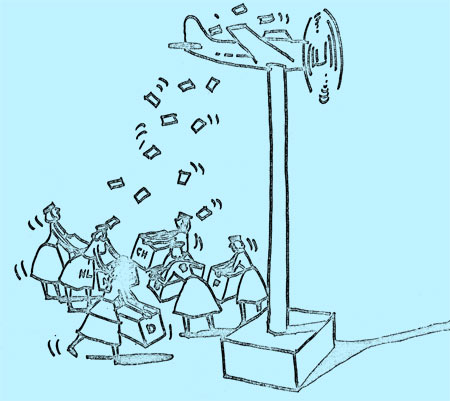 |
|
Image © WDR, 1975 |
| |
|
Running Scores and Positions:
1st Montfoort (NL) (6pts awarded / 6pts
total)
2nd Kilmarnock (GB) (5pts / 5pts)
3rd Füssen im Allgäu (D) (4pts / 4pts)
4th Faido (CH) (3pts / 3pts)
5th Bosa (Sardegna) (I) (2pts / 2pts)
6th Temse (B) (1pt / 1pt)
7th Aix-les-Bains (F) (--- / 0pts) |
Game 2 - Der Gepäckwagen (The Luggage Van)
Without Great Britain. 5 men plus the Team Captain. 3 heats of
2 teams. The driver operates an electronic post-wagon which has behind it four
small wagons. The wagons are connected to each other by the competitors
standing on each wagon holding hands. The train travels through a circuitous
route. If the chain breaks the driver must reverse the wagon to make up the
chain once again. There will be a draw for each electric wagon.
| |
|
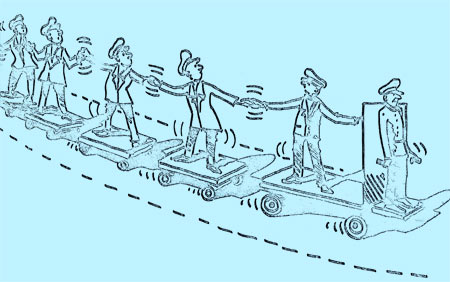 |
|
Image © WDR, 1975 |
| |
|
Running Scores and Positions:
1st Montfoort (NL) (6pts awarded / 12pts
total)
=2nd Faido (CH) (5pts / 8pts) ▲
=2nd Füssen im Allgäu (D) (4pts / 8pts) ▲
4th Kilmarnock (GB) (--- / 5pts) ▼
=5th Temse (B) (3pts / 4pts) ▲
=5th Bosa (Sardegna) (I) (2pts / Joker / 4pts)
7th Aix-les-Bains (F) (2pts / 2pts) |
Game 3 - Briefe Stempeln (Franking Letters)
Without Italy. 1 girl per team. 2 heats of
3 teams. The girl competitor is disguised as a rubber stamp. At the beginning
of the game she must lift up her skirt and jump on to a pad which is covered
with ink. Having collected ink on her she must then hop forward to one of the
letters which is laid out in front of her and frank the stamp. Each time she
returns to the stamping pad and the winner will be the girl which franks the
most letters.
| |
|
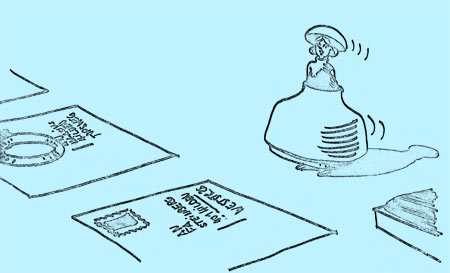 |
|
Image © WDR, 1975 |
| |
|
Running Scores and Positions:
1st Kilmarnock (GB) (12pts awarded / Joker
/ 17pts total) ▲
2nd Montfoort (NL) (4pts / 16pts) ▼
=3rd Temse (B) (10pts / Joker / 14pts) ▲
=3rd Faido (CH) (6pts / Joker / 14pts) ▼
5th Füssen im Allgäu (D) (2pts / 10pts) ▼
6th Bosa (Sardegna) (I) (--- / 4pts) ▼
7th Aix-les-Bains (F) (1pt / 3pts) |
Game 4 - Die Schliessfächer (The Lockers)
In Game 4 - ‘Die Schliessfächer (The Lockers)’ - six male competitors were dressed as German postmen
who had been blindfold and had to negotiate an obstacle course which had a
number of turnstiles on it. Some of these turnstiles had to be entered and
some were just for scenery purposes. At the end of the course the teams had to
open a small door in a wall marked Schleißfächer (loosely translated into
English as ‘safety deposit box’) which contained a parcel. After collecting
the parcels, the postmen had to make their way back to the start of the course
and into a holding area to finish the game. Swiss team Faido seemed to have no
problem negotiating the course and won the game, followed by the Belgian team
of Temse. Although British competitor Gordon Black had negotiated the first
part of the course as quickly as the Swiss player, he got lost in the maze of
turnstiles on the return leg and finished in fifth place. The West German
competitor in the meantime made a complete shambles of the game and found
himself going back and forth through the same turnstile. Despite the fact that
his antics proved amusing to the assembled spectators, the stadium was filled
with boos and hisses when he finished in last place on the game!
| |
|
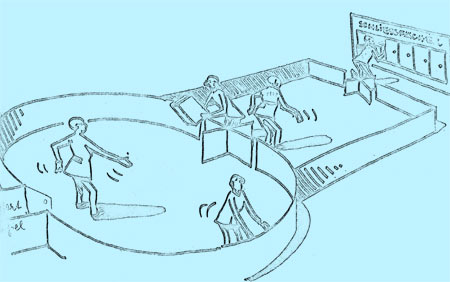 |
|
Image © WDR, 1975 |
| |
|
Running Scores and Positions:
1st Faido (CH) (6pts awarded / 20pts total)
▲
2nd Kilmarnock (GB) (2pts / 19pts) ▼
3rd Temse (B) (3pts / 17pts)
4th Montfoort (NL) (--- / 16pts) ▼
5th Füssen im Allgäu (D) (1pt / 11pts)
=6th Aix-les-Bains (F) (5pts / 8pts) ▲
=6th Bosa (Sardegna) (I) (4pts / 8pts) |
Game 5 - Die Telefonverbindungen (Telephone Connections)
Game 5 - ‘Die Telefonverbindungen (Telephone Connections)’ - involved the participation from the six
competing countries’ commentators. The idea of the game was to make a landline
connection from each of the female competitors on the ground at the start of
the game, to the commentators high in their commentary boxes. On the whistle,
a male competitor from each team climbed one of the telegraph poles and made
the first connection to the ground. He then had to make a second connection to
the same pole and throw the wire to a team-mate on the second pole. This was
repeated until all four poles were connected. Once completed, the commentator
then had to shout out (this was audible to all in the stadium) one of four
place names that had been placed on a board at the start of the game. The
female competitor then had to place this name on a telegram envelope and hand
it to her team-mate at the top of the first pole. British commentator Stuart
Hall can clearly be heard shouting out “Leeds! Leeds!” to the British
competitor.
| |
|
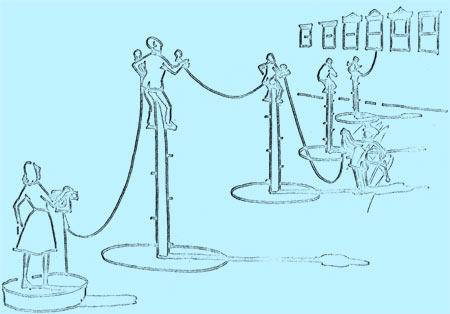 |
|
Image © WDR, 1975 |
| |
|
Running Scores and Positions:
1st Faido (CH) (6pts awarded / 26pts total)
2nd Kilmarnock (GB) (3pts / 22pts)
3rd Füssen im Allgäu (D) (10pts / Joker / 21pts) ▲
4th Montfoort (NL) (2pts / 18pts)
5th Temse (B) (--- / 17pts) ▼
6th Aix-les-Bains (F) (4pts / 12pts)
7th Bosa (Sardegna) (I) (1pt / 9pts) ▼ |
Game 6 - The Money Postman
This game was originally planned as 'Der Gelbote (The Postman)'
but it was replaced before the recording.
|
Running Scores and Positions:
1st Montfoort (NL) (10pts awarded / Joker
/ 28pts total) ▲
=2nd Faido (CH) (--- / 26pts) ▼
=2nd Kilmarnock (GB) (4pts / 26pts)
4th Füssen im Allgäu (D) (1pt / 22pts) ▼
5th Temse (B) (3pts / 20pts)
6th Aix-les-Bains (F) (6pts / 18pts)
7th Bosa (Sardegna) (I) (2pts / 11pts) |
Game 7 - Das Fleissband
(The Conveyer Belt)
Without Germany. 1 man, 3 girls. 3 heats of 2 teams. A narrow
carpet, 15m in length, is fixed at either end of the course. The male
competitors must push the parcels which are supplied, along the carpet and as
they arrive at a certain platform along the course, the girl competitor stamps
them as indicated on the drawing. The parcels should then be delivered to the
end of the carpet and placed in a pile. The winner will be the team which
transports the largest number of parcels in the shortest time.
| |
|
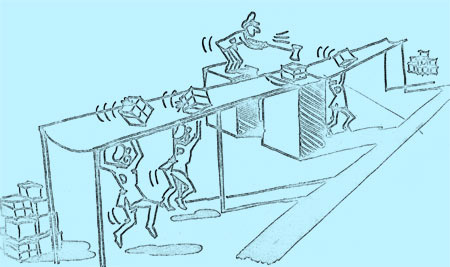 |
|
Image © WDR, 1975 |
| |
|
Running Scores and Positions:
1st Montfoort (NL) (5pts awarded / 33pts
total)
2nd Faido (CH) (6pts / 32pts)
3rd Kilmarnock (GB) (2pts / 28pts) ▼
4th Aix-les-Bains (F) (8pts / Joker / 26pts) ▲
5th Temse (B) (3pts / 23pts)
6th Füssen im Allgäu (D) (--- / 22pts) ▼
7th Bosa (Sardegna) (I) (2pts / 13pts) |
Fil Rouge - Vorsicht!
Bissige Hunde! (Beware of the Dog!)
1 man, 1 girl plus 2 boys disguised as dogs from an opposing
team. The girl competitor stands at the door of the house and the postman
stands at the garden gate. Between the two of them is a revolving carpet on
which stand the two opposing team members dressed as dogs. If the dogs do not
keep their balance they will be taken by the revolving carpet and deposited in
a pool by the side of the house. The postman throws the letters to the girl
and the dogs attempt to stop these letters reaching her. The winner will be
the team who collects the greatest number of letters in the time allowed for
the game.
| |
|
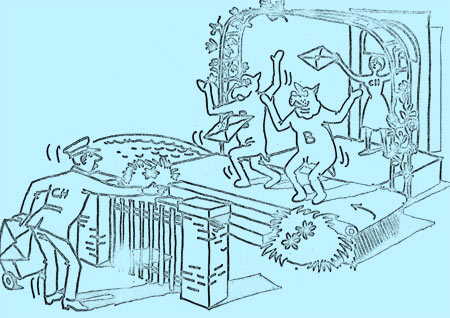 |
|
Image © WDR, 1975 |
| |
|
Final Fil Rouge Standings:
1st Faido (CH)
2nd Füssen im Allgäu (D)
3rd Temse (B)
4th Aix-les-Bains (F)
=5th Bosa (Sardegna) (I)
=5th Montfoort (NL)
7th Kilmarnock (GB) |
|
Running Scores and Positions:
1st Faido (CH) (7pts awarded / 39pts total)
▲
2nd Montfoort (NL) (3pts / 36pts) ▼
3rd Aix-les-Bains (F) (4pts / 30pts) ▲
4th Kilmarnock (GB) (1pt / 29pts) ▼
=5th Temse (B) (5pts / 28pts)
=5th Füssen im Allgäu (D) (6pts / 28pts) ▲
7th Bosa (Sardegna) (I) (3pts / 16pts) |
Game 8 - Die Pakete
(The Parcels)
1 man, 1 girl. 1 heat of 7 teams. At the beginning of the
course there are a large quantity of parcels of varying sizes. The postman
will be given several pieces of small cord in order to tie the parcels
together. He is allowed to tie them in any order he wishes and having done
this he must set off along an obstacle course. He eventually arrives at a
door, he must ring the bell and the girl competitor then opens the door, helps
him through and assists him in piling up the parcels.
| |
|
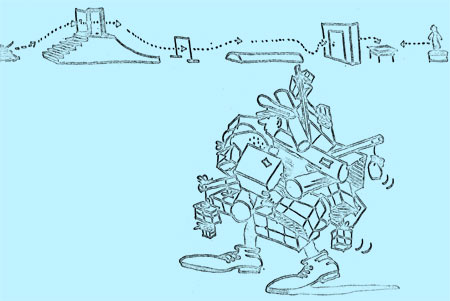 |
|
Image © WDR, 1975 |
| |
|
Running Scores and Positions:
1st Faido (CH) (7pts awarded / 46pts total)
2nd Montfoort (NL) (5pts / 41pts)
=3rd Füssen im Allgäu (D) (6pts / 34pts) ▲
=3rd Aix-les-Bains (F) (4pts / 34pts)
5th Temse (B) (3pts / 31pts)
6th Kilmarnock (GB) (1pt / 30pts) ▼
7th Bosa (Sardegna) (I) (2pts / 18pts) |
|
|
Presenters, Officials and Production Team |
|
After Game 3 - ‘Briefe Stempeln (The Rubber Stamp)’ - Erhard Keller approached the British
competitor Ann Mattison and asked her “Are you a stamp collector”. She
replied, “I do not get enough letters to do that”. Erhard Keller then
inadvertently said to her, “I am sure that there are plenty of young men who
would like to show you theirs!” Realising his error, he laughed and quickly
added, “their stamps!” |
|
Additional Information |
|
The theme for this heat was inspired by the huge telecommunications tower that
stands in Luisenpark next to Kutzerweiher (Kutzer’s pond).
The West German television service once again staged a fully-costumed
International Heat which was not only entertaining, but at times was very
funny. Following the opening credits and short introductory film of Mannheim,
the camera panned down the visiting countries’ commentary boxes into the arena.
A stagehand dressed in a large foam-rubber postman’s costumed entered the
arena pushing a trolley which was loaded with seven large packages. These
boxes were to be used in a unique piece of Jeux Sans Frontières
television ‘magic’. The trolley was deposited with presenters Erhard Keller
and Marie-Louise Steinbauer and Erhard turned to the cameras and said he
wondered what the packages were for. He stated that the first one was
addressed to the Rhein-Neckar Stadium in Mannheim and he tossed it to the
ground. The next six were individually addressed to the other six towns and
these were also tossed to the ground. The camera then panned to the discarded
packages on the stadium floor and as a loud fanfare was played, the seven
teams burst forth from the ‘packages’. Although the assembled crowd would not
have witnessed the real effect of the trick, it certainly worked well for the
viewers at home!
After the fourth heat of the Fil Rouge there was another comical moment. The
Dutch team of Montfoort had just completed a 10-second restart as a result of
the equipment being used stopping before the game had been completed. The
opposing team from Temse in Belgium were dressed as large dogs, and after the
final whistle was blown, one of their competitors walked on all fours to the
bench which had been separating his team from the girl from Montfoort, lifted
his right back leg and pretended to relieve himself. Well, you would if you
were a dog, wouldn’t you? Classic!
After three games, Swiss team Faido had already played their Joker and were
lying in third place on the master scoreboard with just 14pts. The team then
made one of the most incredible comebacks in the history of the programme by
winning their next four games as well as the Fil Rouge - a total of 32pts from
five games! Today this still remains a record in Jeux Sans Frontières
and has only ever been equalled once. On that occasion, it was in
International Heat 1 in 1977, when the Italian team of Marina di Carrara also
won their last four games as well as the Fil Rouge. However their amassed
total for the five games was 38 pts, the difference being that one of those
games was on the Joker.
The Swiss TV broadcasters breathed a huge sigh of relief after Faido won this
heat. This was the first win for Switzerland in an International Heat since
Locarno tied jointly with Belgian team Genk in International Heat 5 in 1970 -
an incredible record unbroken run of 34 International Heats without a victory!
However, during this ‘lean period’ Switzerland managed to win two
International Finals - one in 1972 and another in 1974.
The team from this heat’s host town Mannheim were beaten by Füssen im Algäu in the West
German Domestic series Spiel Ohne Grenzen and therefore failed to earn
the right to participate in the event staged in their home town! |
|
Made
in Colour • This programme exists in the BBC Archives |
|
|
|
F |
Jeux
Sans Frontières 1975 |
Heat
6 |
|
Event Staged: Tuesday 29th July 1975
Venue:
Place Stanislas, Nancy, France
European Transmissions (Local Timings):
BRT (B): Tuesday 29th July 1975, 9.05-10.20pm (Live)
SSR (CH): Tuesday 29th July 1975, 9.05-10.25pm (Live)
SRG (CH): Tuesday 29th July 1975, 9.05-10.25pm (Live)
WDR 1 (D): Tuesday 29th July 1975, 9.05-10.30pm (Live)
Nederland 2 (NL): Tuesday 29th July 1975, 9.05-10.35pm (Live)
RTB (B): Tuesday 29th July 1975, 9.10-10.20pm (Live)
RAI Due (I): Tuesday 29th July 1975, 10.05-11.30pm (Live - DST)
TSI (CH): Wednesday 30th July 1975, 9.00-10.15pm
RTP 2 (P): Tuesday 2nd September 1975, 10.00-11.30pm
BBC1 (GB exc. Wales): Wednesday 1st October 1975,
6.45-8.00pm
BBC1 Wales (CYM): Sunday 5th October 1975, 1.55-3.15pm
Winners' Trophy presented by: M. Marcel Martin, Mayor of
Nancy |
|
Theme:
The Splendours of Stanislas Leszczynski |
|
Teams: Houdeng-Aimeries
(B) v. Adliswil (CH)
v. Simmern (D) v. Nancy (F) v.
Portsmouth and Southsea (GB) v. Bordighera (I) v. Bedum (NL) |
|
Team Members
included:
Nancy (F) - André Laurain (General Captain), Jean Pierre Desquatre (Team Captain),
Anne Marie Blot, Joëlle Carpentier,
Thierry Dabrowski, Jacques Dechoux, Marie France Gauge, André Leblanc,
François Lombard, Josette Lombard, Alain Macchia, Jean Novena, Maurice
Rejwerski, Christian Ries and Nadine Thirion;
Portsmouth and Southsea (GB) - Michael Horrocks (Team Captain),
Bob Atkinson, Ian Chivers, Terri Hadey, Alan Hallam, Steve Knutt, Bill Leng,
Anne Smart, Debbie Walters;
Bedum (NL) - Ko Panneman (Team Manager), Poppe Jellema (Team
Coach), Tjeerd Hoekstra (Team Physio), Piet Lanting (Team Captain), Henk Übels
(Superzeskamper), Lineke Arends, Bart Diephuis, Ebel Drenth, Tineke
Groenewolt, Tineke Hersevoort, Annet Kleersnijder, Fred Kruizinga, Wicher
Nieborg, Johan Reining, Anja Rutgers, Grietha Übels, Ubellenus Übels, Zwannie
Übels, Joke Schuitema, Erik van de Vries, Trijnie de Vries, Ankie Witsenboer,
Bert Zwerver. |
|
Games:
The Beer Festival, The Pearl Robbers, The Building of Nancy, Pirates of the
Meurthe, Les Artilleurs du Prince (The Prince’s Artillery Men), La Course des
Chaises à Porteurs (The Sedan Chair Race), Diamonds Are a Girl's Best Friend and
Les Astronomes du Prince (The
Prince’s Astronomers);
Fil Rouge: Le Dejeuner du Prince (The Prince's Luncheon);
Jokers: Thistles. |
|
Game Results and Standings |
|
Games |
|
Team /
Colour |
1 |
2 |
3 |
4 |
5 |
6 |
7 |
FR |
8 |
Points Scored
(Joker games shown in red) |
|
B |
1 |
2 |
2 |
--- |
4 |
3 |
1 |
1 |
5 |
|
CH |
4 |
4 |
6 |
1 |
--- |
10 |
2 |
5 |
6 |
|
D |
4 |
2 |
10 |
4 |
3 |
--- |
6 |
3 |
4 |
|
F |
6 |
5 |
3 |
6 |
6 |
12 |
--- |
7 |
3 |
|
GB |
--- |
3 |
2 |
3 |
2 |
8 |
3 |
6 |
1 |
|
I |
2 |
--- |
4 |
2 |
1 |
2 |
10 |
2 |
2 |
|
NL |
5 |
6 |
--- |
5 |
5 |
1 |
8 |
4 |
7 |
Running Totals
(Leading teams shown in red) |
|
B |
1 |
3 |
5 |
5 |
9 |
12 |
13 |
14 |
19 |
|
CH |
4 |
8 |
14 |
15 |
15 |
25 |
27 |
32 |
38 |
|
D |
4 |
6 |
16 |
20 |
23 |
23 |
29 |
32 |
36 |
|
F |
6 |
11 |
14 |
20 |
26 |
38 |
38 |
45 |
48 |
|
GB |
0 |
3 |
5 |
8 |
10 |
18 |
21 |
27 |
28 |
|
I |
2 |
2 |
6 |
8 |
9 |
11 |
21 |
23 |
25 |
|
NL |
5 |
11 |
11 |
16 |
21 |
22 |
30 |
34 |
41 |
|
|
|
Result |
Team |
Points |
Final Scoreboard |
|
1st
2nd
3rd
4th
5th
6th
7th |
F
• Nancy
● ●
NL • Bedum
CH • Adliswil
D • Simmern
GB • Portsmouth and Southsea
I • Bordighera
B • Houdeng-Aimeries |
48
41
38
36
28
25
19 |
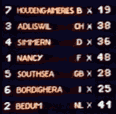 |
|
The Venue |
|
Nancy, France
This heat was held in Place Stanislas in the heart of
Nancy, named after the
former Duke of Lorraine, Stanisław Leszczyński. The theme of this heat was
centred on Stanisław who was actually born in Lviv, Ukraine, in 1677, but
became Duke of Lorraine in 1737 after losing the throne of the
Polish-Lithuanian Commonwealth. After his death in 1766 at Lunéville, France
(a near neighbour town to Nancy which had competed in the programme in 1974),
his body was interred in Notre-Dame de Bon-Secours in Nancy, before finally
being exhumed and moved to Wawel Cathedral in Kraków, Poland.
The square, with an area of over 100m², was a major project in urban planning
of the time and was dreamt up by Stanisław to link the old town of Nancy to
the newer city which had been built during the reign of Charles III in the
early 17th century. It was built in honour of his son-in-law, Louis XV, and
construction work began in March 1752 and took a little over three years to
complete, with work finally finishing in November 1755. It is home to the
Hôtel de Ville, also known as Palais de Stanislas, which is the largest
building in the square measuring 98m long and occupying the whole south side
of the square. At the time of recording, the square was a busy traffic
thoroughfare and in order for the programme to be staged there, the local
gendarmerie had all the roads leading into the square closed from late
afternoon to the early hours the next morning. However, since 2004 the square
has been pedestrianised and is now traffic-free.
|
|
The
Rehearsals |
|
French team Nancy had won the rehearsal the previous night with a score of
51pts, which would have been a record at this point (in the then current format) if
repeated on the actual night of recording. However, on the night the team
still won four games outright (one of which was their Joker game) and won the
Fil Rouge as well. In fact, Nancy had already won the contest before the final
game, being 11pts clear of their nearest rivals Netherlands, and it even
looked like the team were heading for a record score in the current seven team
format, but failed to build on their success and only finished in fifth place
in the final game. |
|
The Games in Detail |
|
Game 1 - The Beer Festival
|
Running Scores and Positions:
1st Nancy (F) (6pts awarded / 6pts total)
2nd Bedum (NL) (5pts / 5pts)
=3rd Adliswil (CH) (4pts / 4pts)
=3rd Simmern (D) (4pts / 4pts)
5th Bordighera (I) (2pts / 2pts)
6th Houdeng-Aimeries (B) (1pt / 1pt)
7th Portsmouth and Southsea (GB) (--- / 0pts) |
|
Comments:
The first game was originally
planned to be 'Les Financiers du Prince (The Prince's Financiers)' and was
to have involved one male competitor from each team standing on a
revolving platform and wearing thick rubber protective costumes. The space
around the platform was to have been divided into six equal areas, one for
each country competing in the game. On the whistle, a series of sacks of
gold would be dropped from a horn of plenty onto the centre of the
revolving platform. The idea was that - using only their feet - the
players would have to manoeuvre as many sacks as possible into their
country area, the winning team being the one that had collected the
greater number. |
Game 2 - The Pearl Robbers
|
Running Scores and Positions:
=1st Nancy (F) (5pts awarded / 11pts total)
=1st Bedum (NL) (6pts / 11pts) ▲
3rd Adliswil (CH) (4pts / 8pts)
4th Simmern (D) (2pts / 6pts) ▼
=5th Houdeng-Aimeries (B) (2pts / 3pts) ▲
=5th Portsmouth and Southsea (GB) (3pts / 3pts)
▲
7th Bordighera (I) (--- / 2pts) ▼ |
|
Comments:
The second game was originally
planned to be 'Les Couronnes Princières (The Princely Crowns)' and was to
have been played over two rounds and involve one male and one female
competitor from each team. Princely crowns were to have been hung from a
wall at one end of a pool of water, with planks reaching across the pool
from the wall. The male competitors were to take one crown at a time,
carry it across the pool and throw it to his female team mate who was
going to catch it on a 2m long pole. Over the course of the game, the
plank was to have moved back into to wall and eventually disappear into
it. The winning team would have been the one that had collected the
greater number of crowns. |
Game 3 - The Building of Nancy
|
Running Scores and Positions:
1st Simmern (D) (10pts awarded / Joker /
16pts total) ▲
=2nd Adliswil (CH) (6pts / 14pts) ▲
=2nd Nancy (F) (3pts / 14pts) ▼
4th Bedum (NL) (--- / 11pts) ▼
5th Bordighera (I) (4pts / 6pts) ▲
=6th Houdeng-Aimeries (B) (2pts / Joker / 5pts)
▼
=6th Portsmouth and Southsea (GB) (2pts / 5pts)
▼ |
|
Comments:
The third game was originally
planned to be 'Le Siège de Nancy (The Siege of Nancy)' and was to have
involved one male and two female competitors from each team. A female
competitor of each team was to stand atop a rampart where they were
besieged (much like the eventual Game 3). The idea of the game was that
they would be supplied with loaves of bread by their male team mates.
These would have been delivered in a basket perched at the summit of a
stack of cubes, which the competitors had to carry to the ramparts taking
care that they would not over balance and collapse. The winning team would
have been the one that had collected the greater number of loaves of
bread. |
Game 4 - Pirates of the Meurthe
|
Running Scores and Positions:
=1st Simmern (D) (4pts awarded / 20pts
total)
=1st Nancy (F) (6pts / 20pts) ▼
3rd Bedum (NL) (5pts / 16pts) ▲
4th Adliswil (CH) (1pt / 15pts) ▼
=5th Portsmouth and Southsea (GB) (3pts / 8pts) ▲
=5th Bordighera (I) (2pts / 8pts)
7th Houdeng-Aimeries (B) (--- / 5pts) ▼ |
|
Comments:
In the planning stages this game
was considerably less visually impressive. The galleons were a late
addition and originally the game - at that point called 'Les Joutes du
Prince (The Prince's Ball Game)' - was a much simpler affair, with two
counterweighted planks reaching over a pool from either side. These planks
were to incorporate a receptacle at the end reaching into the pool and a
weight at the 'land' end 20kg heavier than the competitor's own weight. As
with the eventual game, the idea was for the competitors to fill their
rival's tank to the point where it would be heavier than the
counterweight, thereby propelling the losing competitor into the pool. In
the early version of the game, the tank was to be filled with footballs,
whereas in the final version these had been substituted with water thrown
from buckets. |
Game 5 - Les Artilleurs du Prince (The Prince's Artillery Men)
| |
|
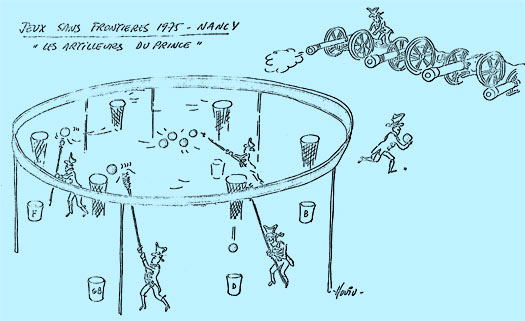 |
|
Image ©
Antenne 2, 1975 |
| |
|
Running Scores and Positions:
1st Nancy (F) (6pts awarded / 26pts total)
2nd Simmern (D) (3pts / 23pts) ▼
3rd Bedum (NL) (5pts / 21pts)
4th Adliswil (CH) (--- / 15pts)
5th Portsmouth and Southsea (GB) (2pts / 10pts)
=6th Houdeng-Aimeries (B) (4pts / 9pts) ▲
=6th Bordighera (I) (1pt / 9pts) ▼ |
|
Comments:
The cartoon illustrations of the
games played at Nancy were drawn by the French-Armenian comic artist René
Horvivian (1929-2005), who signed himself simply 'Hoviv'. His work was
published in many newspapers including Le Hérisson, Marius,
Ici Paris, Jours de France, Lui, Le Quotidien de
Paris and Paris Match. Many of his drawings deal with sexual
behaviours (notably the series Les Mâles) or politics (such Les
Kamarades). In his later years, Hovivian published two albums of drawings
focusing on Armenian life, a subject close to his heart. |
Game 6 - La Course des Chaises à Porteurs (The Sedan Chair Race)
| |
|
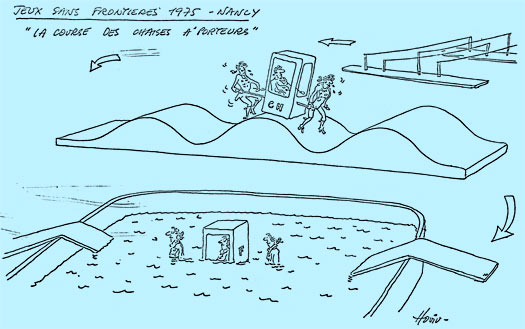 |
|
Image ©
Antenne 2, 1975 |
| |
|
Running Scores and Positions:
1st Nancy (F) (12pts awarded / Joker /
38pts total)
2nd Adliswil (CH) (10pts / Joker / 25pts) ▲
3rd Simmern (D) (--- / 23pts) ▼
4th Bedum (NL) (1pt / 22pts) ▼
5th Portsmouth and Southsea (GB) (8pts / Joker / 18pts)
6th Houdeng-Aimeries (B) (3pts / 12pts)
7th Bordighera (I) (2pts / 11pts) ▼ |
Game 7 - Diamonds are a Girl's Best Friend
|
Running Scores and Positions:
1st Nancy (F) (--- awarded / 38pts total)
2nd Bedum (NL) (8pts / Joker / 30pts) ▲
3rd Simmern (D) (6pts / 29pts)
4th Adliswil (CH) (2pts / 27pts) ▼
=5th Portsmouth and Southsea (GB) (3pts / 21pts)
=5th Bordighera (I) (10pts / Joker / 21pts)
▲
7th Houdeng-Aimeries (B) (1pt / 13pts) ▼ |
|
Comments:
The seventh game was originally
planned to be 'Les Joailliers du Prince (The Prince's Jewellers)' and was to have
involved two male competitors from each team. The first male
was to hold on to and hang from a trapeze fixed on the underside of one
end of a plank that would stretch out over a pool of water. The weight of
the man hanging from the trapeze would allow his team mate to move
up and down the plank. At the poolside end of the plank, there was to have
been a basket containing 'jewels which were to be carried one at a time
along the plank and strung on a necklace string hanging from the far end
of the plank. If the competitor on the trapeze were to let it go, then his
colleague would be upended into the pool. The winning team would
have been the one that had strung the greater number of jewels. |
Fil Rouge, Round 7 - Le Dejeuner du Prince (The Prince's Luncheon)
| |
|
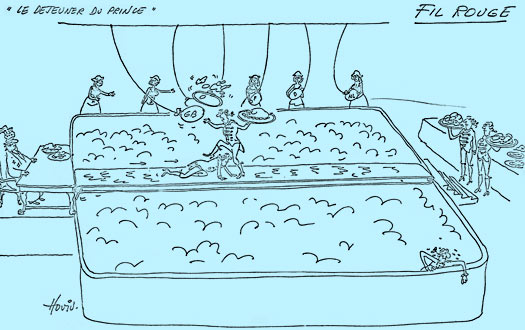 |
|
Image ©
Antenne 2, 1975 |
| |
|
Final Fil Rouge Standings:
1st Nancy (F)
2nd Portsmouth and Southsea (GB)
3rd Adliswil (CH)
4th Bedum (NL)
5th Simmern (D)
6th Bordighera (I)
7th Houdeng-Aimeries (B) |
|
Running Scores and Positions:
1st Nancy (F) (7pts awarded / 45pts total)
2nd Bedum (NL) (4pts / 34pts)
=3rd Adliswil (CH) (5pts / 32pts) ▲
=3rd Simmern (D) (3pts / 32pts)
5th Portsmouth and Southsea (GB) (6pts /
27pts)
6th Bordighera (I) (2pts / 23pts) ▼
7th Houdeng-Aimeries (B) (1pt / 14pts) |
|
Comments:
As with most of the games played
at Nancy, the Fil Rouge was adapted significantly between the event's
planning stages and the night of the contest. As can be seen from René
Hovivian's cartoon, it was initially thought that competitors would be
dislodged from the conveyer belt by swinging sacks. On the night, of
course, the swinging sacks were replaced with giant items of cutlery that
would swing across the moving belt. |
Game 8 - Les Astronomes du Prince (The
Prince’s Astronomers)
| |
|
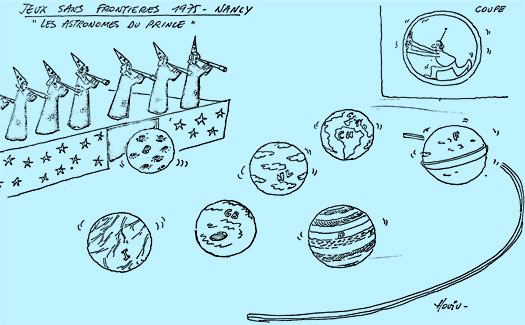 |
|
Image ©
Antenne 2, 1975 |
| |
|
Final
Scores and Positions:
1st Nancy (F) (3pts awarded / 48pts total)
2nd Bedum (NL) (7pts / 41pts)
3rd Adliswil (CH) (6pts / 38pts)
4th Simmern (D) (4pts / 36pts) ▼
5th Portsmouth and Southsea (GB) (1pt /
28pts)
6th Bordighera (I) (2pts / 25pts)
7th Houdeng-Aimeries (B) (5pts / 19pts) |
|
|
Additional Information |
|
Although it would not have affected the outcome of the heat or any positional
changes, the British team of Portsmouth and Southsea were robbed of a point
and a game win in the Fil Rouge. The team had successfully carried 26 dishes
onto the table at the top of the course, but as the touch-judge was counting
them, he inadvertently knocked one of the dishes off the back of the table.
The television camera just manages to catch the shot of this, but it went
unnoticed by everyone. If it had been noticed then the British team would have
won the Fil Rouge along with the French team, and the correct result would
have been 29pts for the British team!
The motto of Nancy is the Latin phrase ‘Non inultus premor’
('No one touches me with impunity'), being a reference to the thistle plant
that is a symbol of Lorraine. It was fitting therefore that thistles were
presented as the Jokers in this heat, as one also appears on the city’s flag. |
|
Made
in Colour • This programme exists in the BBC Archives |
|
|
|
GB |
Jeux
Sans Frontières 1975 |
Heat
7 |
|
Event Staged: Tuesday 12th August 1975
Venue:
Open-Air Sea Bathing Lake, Princes Park, Southport, Great Britain
European Transmissions (Local Timings):
BRT (B): Tuesday 12th August 1975, 9.05-10.20pm (Live)
RTB (B): Tuesday 12th August 1975, 9.10-10.20pm (Live)
SSR (CH): Tuesday 12th August 1975, 9.05-10.25pm (Live)
SRG (CH): Tuesday 12th August 1975, 9.05-10.25pm (Live)
WDR 1 (D): Tuesday 12th August 1975, 9.05-10.30pm (Live)
Nederland 2 (NL): Tuesday 12th August 1975, 9.05-10.25pm (Live)
RAI Due (I): Tuesday 12th August 1975, 10.05-11.30pm (Live - DST)
TSI (CH): Wednesday 13th August 1975, 9.00-10.15pm
RTP 2 (P): Tuesday 16th September 1975, 10.00-11.30pm
BBC1 (GB exc. Wales): Wednesday 8th October 1975,
6.50-8.10pm
BBC1 Wales (CYM): Sunday 12th October 1975, 1.55-3.15pm
Winners' Trophy presented by: Barney Colehan, BBC
Producer |
|
Theme:
The Pirates |
|
Teams:
Waterloo (B) v. Sainte-Croix (CH) v. Baesweiler (D) v. Saint-Gaudens (F) v.
Cambridge (GB) v. Valmadrera (I) v. Steenwijk (NL) |
|
Games Demonstration Team: Southport (GB) |
|
Team Members
included:
Waterloo (B) - Jacques Loquieres;
Sainte Croix (CH) - Denise Blanché, Bernard Weiter;
Baesweiler (D) - Beatrix Coischon, Angelica Lehric, Gerd Norimann, Eva
Simmermans, Norbert Schwantrinck, Kornelia Spielberg, Margret Vornrat;
Saint-Gaudens (F) - Robert Croux (Team Coach), Brigitte Ousset (Team
Captain), Marianne Baillant, Michele Narbone, Patrick Rive;
Cambridge (GB) - Mike Boardman (Team Manager), Eddie Sharp
(Co-Team Coach), Terry Welham (Co-Team Coach), Derek Allinson, Robert Baldwin,
Jane Barber, Anthea Beauchamp, Tony Bevan, Chandrasekhar Bodapati, Phillip
Bramford, Patricia Buck, Caroline Cannon, Julie Dias, Hallam Doyle, Ann Ekin,
Helen Ford, Jane Freeman, Claire Goodwin, Christopher Heron, Glenn Horridgee,
Shelagh James, Lesley Kemp, Michael Lamb, Maria Mastella, Colin Mathieson,
Angela Maxted, Maureen Parnell, Michael Rayson, Linda Roberts, Susan Sanford,
Roger Sanford, John Saxton, Derek Smiley, Roger Steedman, Alison Stevens,
David Stevens, Diane Stevens, Nicola Stevens, Melvyn Stewart, Paul Stewart,
Steven Tennant, Ian Thompson, Stuart Weston;
Steenwijk (NL) - Eska Bolk, Claudine van Heuten, Joop Jansen,
Anita de Jong. |
|
Games
(Official Titles): Boarding Party, Setting Sail, Man Overboard, Bread Boat,
Raising the Anchor, Provisioning the Ship, Walking the
Plank and Abandon Ship;
Fil Rouge: Rescue;
Reserve Game: Rope Climb (unused);
Jokers: Pirates with Parrots. |
|
Game Results and Standings |
|
Games |
|
Team /
Colour |
1 |
2 |
3 |
4 |
5 |
6 |
7 |
FR |
8 |
Points Scored
(Joker games shown in red) |
|
B |
5 |
1 |
--- |
1 |
12 |
4 |
6 |
1 |
6 |
|
CH |
2 |
3 |
2 |
--- |
3 |
6 |
3 |
4 |
7 |
|
D |
6 |
6 |
3 |
5 |
--- |
3 |
5 |
1 |
1 |
|
F |
2 |
4 |
6 |
4 |
3 |
--- |
1 |
1 |
3 |
|
GB |
6 |
4 |
5 |
2 |
2 |
1 |
--- |
7 |
2 |
|
I |
--- |
5 |
1 |
3 |
10 |
2 |
4 |
5 |
5 |
|
NL |
4 |
--- |
4 |
6 |
4 |
6 |
4 |
6 |
4 |
Running Totals
(Leading teams shown in red) |
|
B |
5 |
6 |
6 |
7 |
19 |
23 |
29 |
30 |
36 |
|
CH |
2 |
5 |
7 |
7 |
10 |
16 |
19 |
23 |
30 |
|
D |
6 |
12 |
15 |
20 |
20 |
23 |
28 |
29 |
30 |
|
F |
2 |
6 |
12 |
16 |
19 |
19 |
20 |
21 |
24 |
|
GB |
6 |
10 |
15 |
17 |
19 |
20 |
20 |
27 |
29 |
|
I |
0 |
5 |
6 |
9 |
19 |
21 |
25 |
30 |
35 |
|
NL |
4 |
4 |
8 |
14 |
18 |
24 |
28 |
34 |
38 |
|
|
|
Result |
Team |
Points |
Final Scoreboard |
|
1st
2nd
3rd
=4th
=4th
6th
7th |
NL
• Steenwijk
● ●
B • Waterloo
I • Valmadrera
CH • Sainte-Croix
D • Baesweiler
GB • Cambridge
F • Saint-Gaudens |
38
36
35
30
30
29
24 |
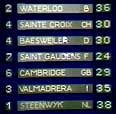 |
|
The Venue |
|
Southport, Great Britain
This heat was held in the Open-Air Sea Bathing Lake located in Southport’s
Princes Park. The aim of the lake, opened in 1926, was to provide a large
open-air sea bathing lake for mixed bathing. The lake was situated in the
Princes Park and cost £60,000 to construct. It was built in the form of an
oval measuring 330ft in length and 212ft in width and was surrounded by a
grass border and gardens. The lake provided room for around 650 bathers. Today,
the pool no longer exists as it was demolished in the late 1980s, and is now a
large retail park, comprising mainly of restaurants such as McDonald’s,
Nando’s and Chiquito’s and a Sports and Fitness Centre.
The impressive galleon which was the centrepiece of the event
was not a true seafaring vessel and had been constructed by the BBC especially
for this International Heat. David Ashurst of Southport takes up the story: "I
remember as a child swimming in the outdoor pool in the summer of 1975, whilst
the big galleon was being built in the deep end of the pool, which was
cordoned off from the regular bathers for the sake of safety. The pool was
only closed to the public a couple of days before the competition was staged,
so we enjoyed watching all the preparations take place around us. As many
people who watched the show knew, the competitors trained hard physically in
order to take part. However, in the case of the Southport event, the
competitors were put through a tough ordeal even by JSF standards as much of
the event was water based and the pool was filled with unheated sea water. To
make matters worse, the Galleon was built over the deep end of the pool and
the event was recorded in the evening once the warmth of the sun had gone -
those waters were very cold indeed. For many years afterwards, there were rust
marks on the sandstone steps in the shallow end of the pool, showing where the
scaffold legs on the staging had been anchored. These acted as the only
poignant reminders of a great fun day, which seems a memory of another
lifetime. Sadly, the Sea Bathing Lake was demolished at the end of the
Eighties, to make way for more modern amenities. It was a great loss to local
people, young and old alike, and also the loss of an architectural gem of a
lido. After the show, the local authority placed the great galleon into
storage, with the intention of it being placed in the local Marine Lake for
all to see. Unfortunately, this plan never became a reality, and I assume the
galleon rotted away over time. It was a magnificent structure and a great
credit to the BBC and local organisers. It was such a shame that it was not
put to use in another way after the show." |
|
The
Rehearsals |
|
The final rehearsal for this heat on the night of Monday 11th August 1975 was
disrupted due to an overheating power generator which caught fire at the
Southport location. After a short period during which Eddie Waring, Stuart
Hall and Gennaro Olivieri lead the audience in a rather tuneless rendition of
Down by the Old Mill Stream to keep everyone entertained, the rehearsal
concluded in low light conditions. The lead-in to the recording had already
been set back due to heavy rain, which had made construction of the set
difficult and had fused the spotlights at the Open-Air Sea Bathing Lake.
The Southport team of 1974 (who had qualified for Jeux Sans Frontières
in Bouillon and were in training to compete in It's A Christmas Knockout)
were brought in by the BBC to demonstrate the games to the competitors. During
the lead-in to the Southport Jeux Sans Frontières, members of the
Southport team participated in a charity cricket match at Birkdale Cricket
Club. This was staged to entertain (and frankly bemuse) some of the visiting
team members and a local audience. The cricket teams included BBC presenters
Stuart Hall and Eddie Waring, International referee Gennaro Olivieri and
comedians George Roper, Les Dawson and Tom O'Connor. O'Connor would go on to
be a guest presenter on It's A Knockout in 1982 and Dawson likewise in
The Grand Knockout Tournament of 1987. Footage from this cricket match
was included in the BBC's Behind the Scenes: Four Days in Southport with
Jeux Sans Frontières documentary which filmed the work behind the scenes
on the Southport It's A Knockout. The documentary was eventually transmitted by the
BBC a year later on Sunday 19th September 1976! |
|
The Games in Detail |
|
Game 1 - Boarding Party
| |
|
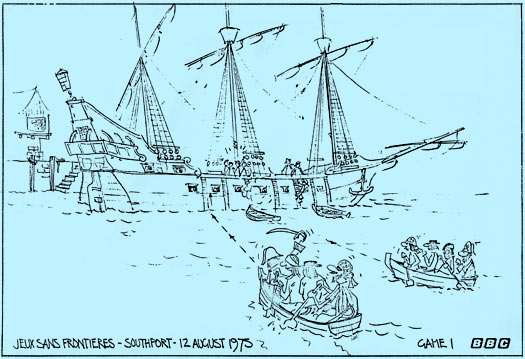 |
|
Image ©
BBC, 1975 |
| |
|
Running Scores and Positions:
=1st Baesweiler (D) (6pts awarded / Joker
/ 6pts total)
=1st Cambridge (GB) (6pts / 6pts)
3rd Waterloo (B) (5pts / 5pts)
4th Steenwijk (NL) (4pts / 4pts)
=5th Sainte-Croix (CH) (2pts / Joker / 2pts)
=5th Saint-Gaudens (F) (2pts / 2pts)
7th Valmadrera (I) (--- / 0pts) |
Game 2 - Setting Sail
| |
|
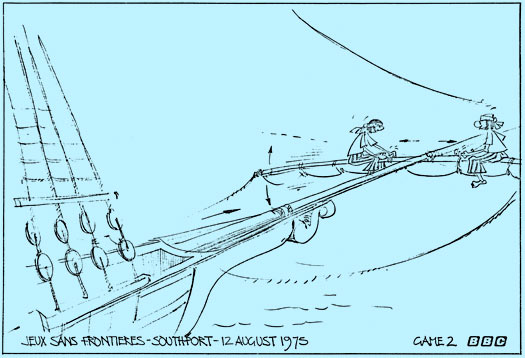 |
|
Image ©
BBC, 1975 |
| |
|
Running Scores and Positions:
1st Baesweiler (D) (6pts awarded / 12pts total)
2nd Cambridge (GB) (4pts / 10pts) ▼
=3rd Waterloo (B) (1pt / 6pts)
=3rd Saint-Gaudens (F) (4pts / Joker / 6pts) ▲
=5th Sainte-Croix (CH) (3pts / 5pts)
=5th Valmadrera (I) (5pts / 5pts) ▲
7th Steenwijk (NL) (--- / 4pts) ▼ |
Game 3 - Man Overboard
| |
|
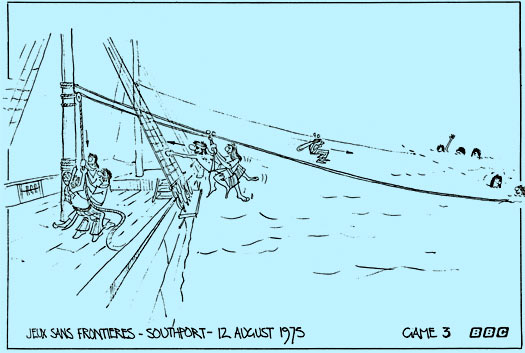 |
|
Image ©
BBC, 1975 |
| |
|
Running Scores and Positions:
=1st Baesweiler (D) (3pts awarded / 15pts total)
=1st Cambridge (GB) (5pts / 15pts) ▲
3rd Saint-Gaudens (F) (6pts / 12pts) ▲
4th Steenwijk (NL) (4pts / 8pts) ▲
5th Sainte-Croix (CH) (2pts / 7pts)
=6th Waterloo (B) (--- / 6pts) ▼
=6th Valmadrera (I) (1pt / 6pts) ▼ |
Game 4 - Bread Boat
| |
|
 |
|
Image ©
BBC, 1975 |
| |
|
Running Scores and Positions:
1st Baesweiler (D) (5pts awarded / 20pts total)
2nd Cambridge (GB) (2pts / 17pts) ▼
3rd Saint-Gaudens (F) (4pts / 16pts)
4th Steenwijk (NL) (6pts / 14pts)
5th Valmadrera (I) (3pts / 9pts) ▲
=6th Waterloo (B) (1pt / 7pts)
=6th Sainte-Croix (CH) (--- / 7pts) ▼ |
Game 5 - Up Anchor
| |
|
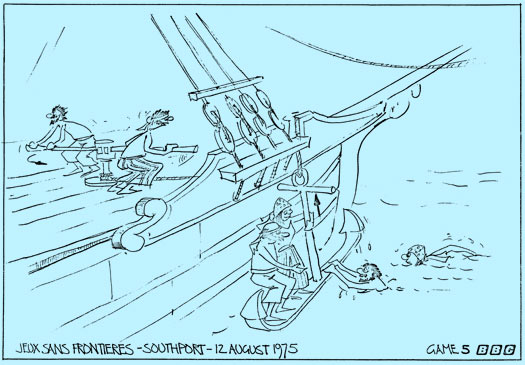 |
|
Image ©
BBC, 1975 |
| |
|
Running Scores and Positions:
1st Baesweiler (D) (--- awarded / 20pts total)
=2nd Waterloo (B) (12pts / Joker / 19pts) ▲
=2nd Saint-Gaudens (F) (3pts / 19pts) ▲
=2nd Cambridge (GB) (2pts / 19pts)
=2nd Valmadrera (I) (10pts / Joker / 19pts) ▲
6th Steenwijk (NL) (4pts / 18pts) ▼
7th Sainte-Croix (CH) (3pts / 10pts) ▼ |
Game 6 - Provisioning the Ship
| |
|
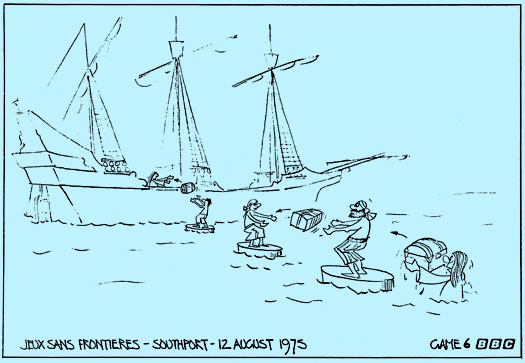 |
|
Image ©
BBC, 1975 |
| |
|
Running Scores and Positions:
1st Steenwijk (NL) (6pts awarded / 24pts
total) ▲
=2nd Waterloo (B) (4pts / 23pts)
=2nd Baesweiler (D) (3pts / 23pts)
4th Valmadrera (I) (2pts / 21pts) ▼
5th Cambridge (GB) (1pt / 20pts) ▼
6th Saint-Gaudens (F) (--- / 19pts) ▼
7th Sainte-Croix (CH) (6pts / 16pts) |
Game 7 - Walking the Plank
| |
|
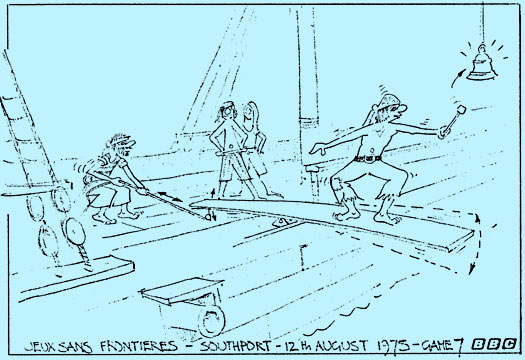 |
|
Image ©
BBC, 1975 |
| |
|
Running Scores and Positions:
1st Waterloo (B) (6pts awarded / 29pts
total) ▲
=2nd Baesweiler (D) (5pts / 28pts)
=2nd Steenwijk (NL) (4pts / Joker / 28pts)
▼
4th Valmadrera (I) (4pts / 25pts)
=5th Saint-Gaudens (F) (1pt / 20pts) ▼
=5th Cambridge (GB) (--- / 20pts) ▲
7th Sainte-Croix (CH) (3pts / 19pts) |
Fil Rouge, Round 7 - Rescue
|
Final Fil Rouge Standings:
1st Cambridge (GB)
2nd Steenwijk (NL)
3rd Valmadrera (I)
4th Sainte-Croix (CH)
=7th Waterloo (B)
=7th Baesweiler (D)
=7th Saint-Gaudens (F) |
|
Running Scores and Positions:
1st Steenwijk (NL) (6pts awarded / 34pts
total) ▲
=2nd Waterloo (B) (1pt / 30pts) ▼
=2nd Valmadrera (I) (5pts / 30pts) ▲
4th Baesweiler (D) (1pt / 29pts) ▼
5th Cambridge (GB) (7pts / 27pts)
6th Sainte-Croix (CH) (4pts / 23pts) ▲
7th Saint-Gaudens (F) (1pt / 21pts) ▼ |
Game 8 - Abandon Ship
|
Final
Scores and Positions:
1st Steenwijk (NL) (4pts awarded / 38pts
total)
2nd Waterloo (B) (6pts / 36pts)
3rd Valmadrera (I) (5pts / 35pts) ▼
=4th Sainte-Croix (CH) (7pts / 30pts) ▲
=4th Baesweiler (D) (1pt / 30pts)
6th Cambridge (GB) (2pts / 29pts) ▼
7th Saint-Gaudens (F) (3pts / 24pts) |
|
|
Presenters, Officials and Production Team |
|
After the Italian team had participated in the third game, presenter Stuart
Hall greeted them, speaking in his
broken Italian language. Before announcing the result, Gennaro Olivieri
somewhat sarcastically said to Stuart Hall, “What lovely Italian language you
speak”. This caused some hilarity not only with Hall but also from the West
German commentary box.
Throughout the competition, both Stuart Hall and co-presenter Eddie Waring
repeatedly referred to the Italian team as Valdamera. On introducing the
Italian competitor at the beginning of the sixth game as coming from
Valdamera, she pointed out to him that the name of the town was Valmadrera and
not Valdamera!
Eddie Waring made a blooper in this heat by stating that this was the 100th
International Heat that Gennaro Olivieri had refereed. However on counting
back (excluding the annual Christmas programmes which were played purely for
fun) this was in fact the 108th International he had refereed! And if the
Winter series of 1965-68 were not included in the total, then this would have
only have been his 89th one! |
|
Looks
Familiar? |
|
Game 3 - 'Raising the Sails' - would later reappear in JSF 1999
Heat 6 at La Castella, Italy, as 'La Vela' (The Sail), the third game of that
programme. |
|
Additional Information |
|
When the teams arrived in the arena on the night of recording, each team
captain presented gifts to each of the other teams: Waterloo (B) presented
T-shirts; Sainte Croix (CH) presented musical boxes; Saint-Gaudens (F)
presented French loaves; Cambridge (GB) presented scarves; Valmadrera (I)
presented chocolates and Steenwijk (NL) presented toiletries. The Baesweiler
(D) team stated that they had misplaced their gifts but hoped that they would
be presented before the team departed. The Southport team from 1974 which
demonstrated the games also presented gifts of T-shirts, sticks of Southport
rock, town guides and plaques to each of the competing teams.
Usually in Jeux Sans Frontières, teams participated in games in random
order. However in this heat (with the exception of Games 1 and 8, where all
teams participated together), the order of play in each game was strictly
alphabetical based upon the teams' country codes (i.e. B, then CH, followed by
D, and so on). If a game was played over three heats, those heats would also
be populated alphabetically, with B paired with CH, D with F, etc. Although
the games were played in alphabetical order, they rotated the starting team so
that each team would have at least one game where they started
first (the exception being the Netherlands. The easiest way to demonstrate the
running order is to reproduce the team orders for the games affected:
|
Game Number |
Order of
Play |
|
Game 2
Game 3
Game 4
Game 5
Game 6
Game 7
Fil Rouge |
B, CH, D, F, GB, I;
CH & D, F & GB, I & NL;
D & F, GB & I, NL & B;
F, GB, I, NL, B, CH;
GB & I, NL & B, CH & D;
I, NL, B, CH, D, F
I, NL, B, CH, D, F, GB |
For
no clear reason, the name of Dutch team Steenwijk was written as ‘Steenwyk’ on
the scoreboard at this heat as well as the International Final. This may sound
stranger than it seemed because when the names of the qualifying teams for the
International Final were displayed at the end of the programme, the name was
displayed correctly as Steenwijk! |
|
Made
in Colour • This programme exists in the BBC Archives |
|
|
|
Teams
Qualifying for International Final |
|
Country |
Team |
Qualifying Heat |
Position |
Points |
|
B |
Knokke-Heist |
1 |
B |
2 |
40 |
|
CH |
Faido |
5 |
D |
1 |
46 |
|
D |
Bietigheim-Bissingen |
2 |
NL |
1 |
46 |
|
F |
Nancy |
6 |
F |
1 |
48 |
|
GB |
Swansea |
2 |
NL |
2 |
40 |
|
I |
Riccione |
3 |
I |
1 |
42 |
|
NL |
Steenwijk |
7 |
GB |
1 |
38 |
|
|
|
|
|
B |
Jeux
Sans Frontières 1975 |
International
Final |
|
Event Staged: Tuesday 26th August 1975
Venue:
Grote Markt, Ieper / Ypres, Belgium
European Transmissions (Local Timings):
BRT (B): Tuesday 26th August 1975, 9.05-10.25pm (Live)
RTB (B): Tuesday 26th August 1975, 9.05-10.20pm (Live)
SSR (CH): Tuesday 26th August 1975, 9.05-10.25pm (Live)
SRG (CH): Tuesday 26th August 1975, 9.05-10.25pm (Live)
TSI (CH): Tuesday 26th August 1975, 9.05-10.25pm (Live)
WDR 1 (D): Tuesday 26th August 1975, 9.05-10.30pm (Live)
Nederland 2 (NL): Tuesday 26th August 1975, 9.05-10.45pm (Live)
RAI Due (I): Tuesday 26th August 1975, 10.05-11.30pm (Live - DST)
RTP 2 (P): Tuesday 30th September 1975, 10.00-11.30pm
BBC1 (GB exc. Wales): Wednesday 15th October 1975,
6.50-8.10pm
BBC1 Wales (CYM): Sunday 19th October 1975, 1.55-3.15pm
Winners’ Trophies presented by: Paul Boule, Controller of BRT
Television |
|
Theme:
Love and Marriage |
|
Teams:
Knokke-Heist (B) v. Faido (CH) v. Bietigheim-Bissingen (D) v.
Nancy (F) v. Swansea (GB) v. Riccione (I) v. Steenwijk (NL) |
|
Team Members
included:
Faido (CH) - Renata Gobi;
Knokke-Heist (B) - Paul van der Kochkerholm;
Bietigheim-Bissingen (D) - Rolf Schube (Team Coach), Hannelore
Grimm (Team Coach), Klaus Britsch, Inge Gleich, Günter Heinle, Karl-Heinz
Jablinski, Wolfgang Jogwer, Frieder Kling, Markus Kling, Bärbel Mack, Gerhard
Müller, Jürgen Ruof, Wolfgang Sinn, Ellen Tiedtke, Edeltraud Wachtler,
Christian Walter;
Nancy (F) - André Laurain (General Captain), Jean Pierre Desquatre (Team Captain),
Anne Marie Blot, Joëlle Carpentier,
Thierry Dabrowski, Jacques Dechoux, Marie France Gauge, André Leblanc,
François Lombard, Josette Lombard, Alain Macchia, Jean Novena, Maurice
Rejwerski, Christian Ries and Nadine Thirion;
Swansea (GB) - Alan Major (Team Trainer), Robert Sullivan (Team
Captain), J Alksanas, Jeff Buller, D Davies, Christine Griffiths, J Griffiths,
S Hayler, Susan Isaac, J Jones, Lee Jones, R Luke, A Mages, Chris Moore, Paul
Preedy, P Ronan, Robert Shaddick, Steve Seaman, William Sterio, G Sullivan,
Peter Thomas, Wendy Watson, Rose Williams, Mandy Wood, S Yeandle;
Riccione (I) - Leopoldo Carlini (Co-Team Coach), Tiziano
Mulazzoni (Co-Team Coach), Franco Geminiani (Team Captain), Giuliana Amici, Maria Luisa Balzelli, Giovanni
Bezzi, Cecilia Bindelli, Luciano Caimi, Stefano Carlini, Katya Cerri, Stefania
Conti, Walter Corbelli, Daniela de Nittis, Dario Dradi, Margherita Gasparini, Roberto Giannini, Federico Guardagli,
Fernanda Lanci, Dario Lorenzini, Renzo Magnani, Ugo Montevecchi, Davide Monti,
Gabriella Moretto, Giorgi Mulazzoni, Riccardo Mulazzoni, Monica Mussoni, Pierluigi Pellizzola,
Riccardo Proti, Leda Ricci, Santo Rossi, Vittorio Servadio, Maurizio Sorci,
Roberto Tontini, Maria Ugolini and Patrizia Vandi;
Steenwijk (NL) - Eska Bolk, Claudine van Heuten, Joop Jansen,
Anita de Jong. |
|
Games
(Official Titles): Grotbewoners (Cave-Dwellers), Bruidsgeschenken (Bridal
Gifts), Just Married (Just Married), De Wasdag (Washing Day), De Ooievaar (The
Stork), Eerlijk Delen (Fair Sharing), Het Ontbijt (Breakfast) and
Het Behangen (Paper-Hanging);
Fil Rouge: De Jaloerse Vrouwen (The Jealous Women);
Jokers: Cats. |
|
Game Results and Standings |
|
Games |
|
Team /
Colour |
1 |
2 |
3 |
4 |
5 |
6 |
7 |
FR |
8 |
Points Scored
(Joker games shown in red) |
|
B |
4 |
2 |
6 |
4 |
3 |
3 |
--- |
7 |
5 |
|
CH |
1 |
1 |
5 |
1 |
1 |
--- |
2 |
5 |
7 |
|
D |
1 |
--- |
4 |
6 |
2 |
3 |
12 |
1 |
3 |
|
F |
5 |
12 |
--- |
5 |
4 |
6 |
3 |
6 |
4 |
|
GB |
6 |
3 |
1 |
--- |
6 |
5 |
5 |
3 |
1 |
|
I |
--- |
5 |
12 |
2 |
5 |
3 |
2 |
5 |
6 |
|
NL |
6 |
8 |
2 |
3 |
--- |
4 |
4 |
3 |
2 |
Running Totals
(Leading teams shown in red) |
|
B |
4 |
6 |
12 |
16 |
19 |
22 |
22 |
29 |
34 |
|
CH |
1 |
2 |
7 |
8 |
9 |
9 |
11 |
16 |
23 |
|
D |
1 |
1 |
5 |
11 |
13 |
16 |
28 |
29 |
32 |
|
F |
5 |
17 |
17 |
22 |
26 |
32 |
35 |
41 |
45 |
|
GB |
6 |
9 |
10 |
10 |
16 |
21 |
26 |
29 |
30 |
|
I |
0 |
5 |
17 |
19 |
24 |
27 |
29 |
34 |
40 |
|
NL |
6 |
14 |
16 |
19 |
19 |
23 |
27 |
30 |
32 |
|
|
|
Result |
Team |
Points |
Final Scoreboard |
|
1st
2nd
3rd
=4th
=4th
6th
7th |
F
• Nancy
●
I • Riccione
●
B • Knokke-Heist
●
D • Bietigheim-Bissingen
NL • Steenwijk
GB • Swansea
CH • Faido |
45
40
34
32
32
30
23 |
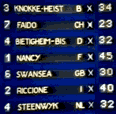 |
|
The Venue |
|
Ieper, Belgium
This heat was held in the beautiful Market Square in
Ieper (also known by its French name Ypres) in front of the
Cloth and City Halls. The two buildings have had a chequered history with both
being heavily damaged during World War I. After the war with money paid by
Germany in reparations under the Treaty of Versailles in 1919, the main square
including the two buildings were built as close to the original designs as
possible.
|
|
The Games in Detail |
|
Game 1 - Grotbewoners (Cave-Dwellers)
At the starting signal, both men run across a narrow plank to
the caves where they use a club to break down an expanded polystyrene panel.
They pull out a giant woman and haul her by her hair over the plank and back
to the starting line that also serves as the finishing line. A race against
time.
| |
|
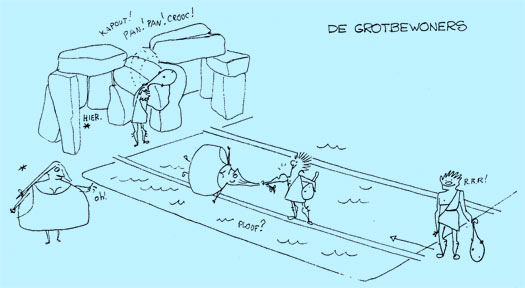 |
|
Image ©
BRT / VRT, 1975 |
| |
|
Running Scores and Positions:
=1st Swansea (GB) (6pts awarded / Joker /
6pts total)
=1st Steenwijk (NL) (6pts / 6pts)
3rd Nancy (F) (5pts / 5pts)
4th Knokke-Heist (B) (4pts / 4pts)
5th Faido (CH) (1pt / 1pt)
6th Bietigheim-Bissingen (D) (1pt / 1pt)
7th Riccione (I) (--- / 0pts) |
Game 2 - Bruidsgeschenken (Bridal Gifts)
One couple piles up ten items (bowls, cups, plates) on a narrow
plank which they carry across an obstacle course to their team members (who
are standing in a giant gift chest). The first couple throws the gifts for the
second couple to catch (all 10 items in minimum time). One girl of the
opposing team will use a bicycle to try and shut the cover of the chest.
| |
|
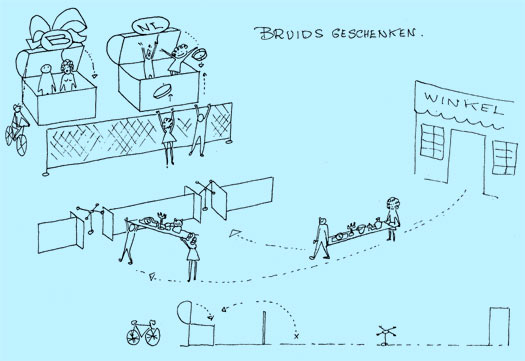 |
|
Image ©
BRT / VRT, 1975 |
| |
|
Running Scores and Positions:
1st Nancy (F) (12pts awarded / Joker /
17pts total) ▲
2nd Steenwijk (NL) (8pts / Joker / 14pts) ▼
3rd Swansea (GB) (3pts / 9pts) ▼
4th Knokke-Heist (B) (2pts / 6pts)
5th Riccione (I) (5pts / 5pts) ▲
6th Faido (CH) (1pt / 2pts) ▼
7th Bietigheim-Bissingen (D) (--- / 1pt) ▼ |
Game 3 - Just Married (Just Married)
One couple starts off with the car to which two or three very
large containers have been attached. The couple will have to reach the top of
a slope as quickly as possible. On their way, 2 girls and 2 boys of the
opponent team try to shovel as much sand as possible into these containers.
The weight of this sand will make any forward motion even more difficult. At
the end of the track, our couple will jump into a bed set up there. An
exploding fire-cracker ends the game.
| |
|
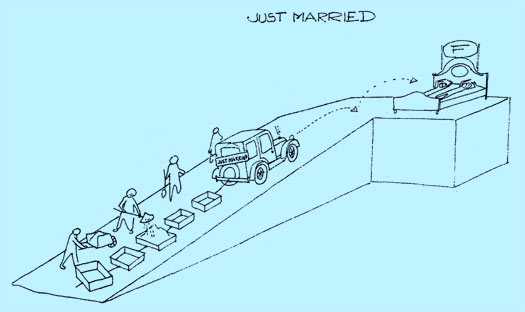 |
|
Image ©
BRT / VRT, 1975 |
| |
|
Running Scores and Positions:
=1st Nancy (F) (--- awarded / 17pts total)
=1st Riccione (I) (12pts / Joker / 17pts) ▲
3rd Steenwijk (NL) (2pts / 16pts) ▼
4th Knokke-Heist (B) (6pts / Joker / 12pts)
5th Swansea (GB) (1pt / 10pts) ▼
6th Faido (CH) (5pts / 7pts)
7th Bietigheim-Bissingen (D) (4pts / 5pts) |
Game 4 - De Wasdag (Washing Day)
A large wash-tub contains a series of clothing items for each
team. At the starting signal, one boy and one girl run to the tub and pick out
one item of the wash to hang it on a clothes-line stretched between two posts.
Two members of the opposing team raise these posts together with the
clothes-line by means of a winch. The purpose is to hang as quickly as
possible all clothing items on the line.
| |
|
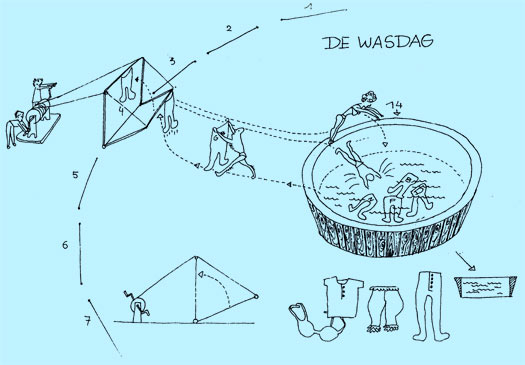 |
|
Image ©
BRT / VRT, 1975 |
| |
|
Running Scores and Positions:
1st Nancy (F) (5pts awarded / 22pts total)
=2nd Riccione (I) (2pts / 19pts) ▼
=2nd Steenwijk (NL) (3pts / 19pts) ▲
4th Knokke-Heist (B) (4pts / 16pts)
5th Bietigheim-Bissingen (D) (6pts / 11pts)
▲
6th Swansea (GB) (--- / 10pts) ▼
7th Faido (CH) (1pt / 8pts) ▼ |
Game 5 - De Ooievaar (The Stork)
At the starting signal the contestant will rush towards a giant
pneumatic mattress while pushing a baby-carriage and crossing an obstacle.
Above this mattress will be suspended a stork holding a baby in its beak. The
contestant will have to jump in order to pluck the baby from the beak; she
will then put the baby into the carriage and push the carriage up to the
finishing line. The purpose will be to bring in one, two or three babies in
minimum time.
| |
|
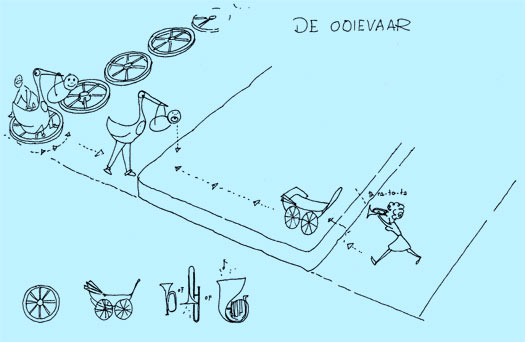 |
|
Image ©
BRT / VRT, 1975 |
| |
|
Running Scores and Positions:
1st Nancy (F) (4pts awarded / 26pts total)
2nd Riccione (I) (5pts / 24pts)
=3rd Knokke-Heist (B) (3pts / 19pts) ▲
=3rd Steenwijk (NL) (--- / 19pts) ▼
5th Swansea (GB) (6pts / 16pts) ▲
6th Bietigheim-Bissingen (D) (2pts / 13pts)
▼
7th Faido (CH) (1pt / 9pts) |
Game 6 - Eerlijk Delen (Fair Sharing)
The bridegroom will attempt to cross a soap-covered track in
order to give banknotes to his bride. Both are held back by elastic rubber
cords. 5 banknotes are to be handed over in the shortest possible time.
| |
|
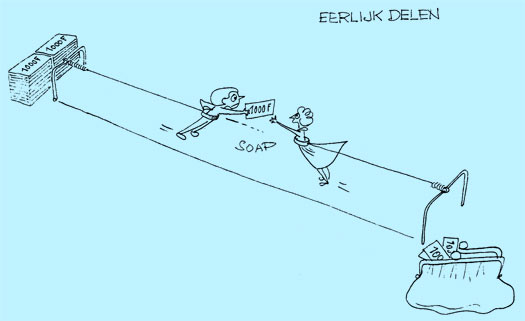 |
|
Image ©
BRT / VRT, 1975 |
| |
|
Running Scores and Positions:
1st Nancy (F) (6pts awarded / 32pts total)
2nd Riccione (I) (3pts / 27pts)
3rd Steenwijk (NL) (4pts / 23pts)
4th Knokke-Heist (B) (3pts / 22pts) ▼
5th Swansea (GB) (5pts / 21pts)
6th Bietigheim-Bissingen (D) (3pts / 16pts)
7th Faido (CH) (--- / 9pts) |
Game 7 - Het Ontbijt (Breakfast)
One contestant uses a conveyor belt to carry the breakfast
ingredients to a small table. Six opponents may use a bag to try and upset the
plate during the crossing. The opponents are also standing on the conveyor
belt.
| |
|
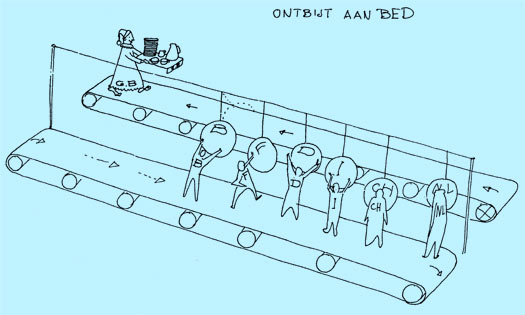 |
|
Image ©
BRT / VRT, 1975 |
| |
|
Running Scores and Positions:
1st Nancy (F) (3pts awarded / 35pts total)
2nd Riccione (I) (2pts / 29pts)
3rd Bietigheim-Bissingen (D) (12pts / Joker
/ 28pts) ▲
4th Steenwijk (NL) (4pts / 27pts) ▼
5th Swansea (GB) (5pts / 26pts)
6th Knokke-Heist (B) (--- / 22pts) ▼
7th Faido (CH) (2pts / Joker / 11pts) |
|
Comments:
This game provided some hilarity
not only during the game but also whilst the referees conferred times. The
idea of the game was that a drunken husband dressed in top hat and tails
would arrive home late from the local bar, only to be met by an angry
wife. On the way from the bar, the husband had to traverse a moving
conveyor belt avoiding large sacks being swung by opposing competitors,
and changing from his evening wear into his pyjamas. On completion of
this, he then dismounted the conveyor belt and had to greet his wife with
a ‘peck’ on the nose. This was actually done by pulling down on the wife’s
nose which released a spring and her arms were raised complete with a
wooden rolling pin in her hand.The first competitor pulled down so hard on
the nose that the nose was pulled from its mounting and fell to the floor.
Whilst replacing it the wife’s bra fell to the floor also, exposing her
bare chest behind. Presenter Mike Verdrengh quickly jumped in and picked
up the bra and replaced it back in place, much to the amusement of the
crowd, referees Gennaro and Guido and Mike himself. The Swiss team of
Faido played in the last heat of the game and failed to come out of the
bar after Gennaro had blown the whistle. After about five seconds he
realised his mistake and came out of the bar and began to play the game.
Gennaro blew the whistle and stopped the game and permitted him to restart
the game. However, despite the restart he made a complete shambles of the
game and finished in last place, and the team had trusted their Joker on
him! |
Fil Rouge - De Jaloerse Vrouwen (The Jealous Women)
One couple will be sitting on a tip-up seat suspended above a
pool. One woman of each opposing team will stand facing this pool while
throwing water-filled bags at the seats. The couple may ward off these bags by
using a broom. As soon as one of these bags hits the safety lock, the seat
will tip up and the player will drop into the pool. The purpose will be to
remain seated for as long as possible.
| |
|
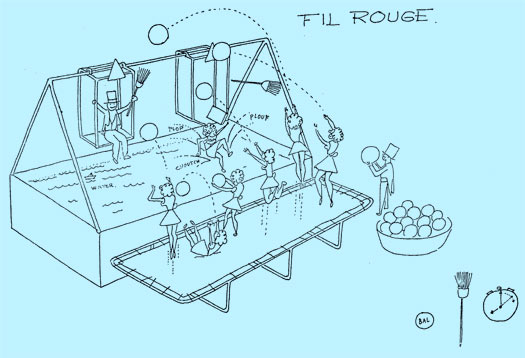 |
|
Image ©
BRT / VRT, 1975 |
| |
|
Final Fil Rouge Standings:
1st Knokke-Heist (B)
2nd Nancy (F)
=3rd Faido (CH)
=3rd Riccione (I)
=5th Swansea (GB)
=5th Steenwijk (NL)
7th Bietigheim-Bissingen (D) |
|
Running Scores and Positions:
1st Nancy (F) (5pts awarded / 41pts total)
2nd Riccione (I) (5pts / 34pts)
3rd Steenwijk (NL) (3pts / 30pts) ▲
=4th Knokke-Heist (B) (7pts / 29pts) ▲
=4th Bietigheim-Bissingen (D) (1pt / 29pts)
▼
=4th Swansea (GB) (3pts / 29pts) ▲
7th Faido (CH) (5pts / 16pts) |
Game 8 - Het Behangen (Paper-Hanging)
Two boys of each team must search a wind tunnel for paper bands
listing a printed slogan in their language. Then they hurry to a girl of their
team who applies the paper-hanger's glue to the band. After this, the boys
will have to glue the bands in their proper sequence to the panel of their
country.
| |
|
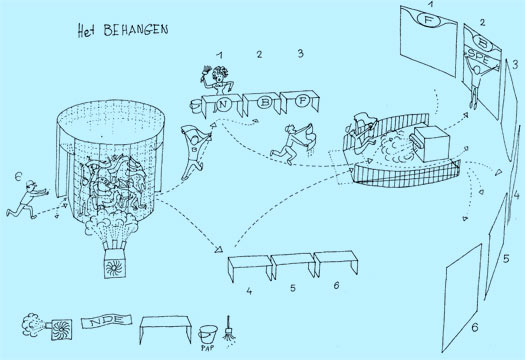 |
|
Image ©
BRT / VRT, 1975 |
| |
|
Final
Scores and Positions:
1st Nancy (F) (4pts awarded / 45pts total)
2nd Riccione (I) (6pts / 40pts)
3rd Knokke-Heist (B) (5pts / 34pts) ▲
=4th Bietigheim-Bissingen (D) (3pts / 32pts)
=4th Steenwijk (NL) (2pts / 32pts) ▼
6th Swansea (GB) (1pt / 30pts) ▼
7th Faido (CH) (7pts / 23pts) |
|
|
Returning
Teams and Competitors |
|
French team Nancy became the second team (joining Dutch team Alphen aan den
Rijn) to reach consecutive International Finals. Having being placed 3rd in
the previous year’s final, the team were determined not to be outdone a second
year running. They were so determined, in fact, that the Nancy team were
celebrating before the final game, because they were 7pts clear of their
nearest rivals Riccione, meaning victory was already theirs. |
|
Additional Information |
|
The
Jokers in this International Final were represented by cats. The reason for
this was that in the Middle Ages, cats were believed to have been an animal of
the Devil, and people used to throw live cats from the rooftops of the
buildings. Today, the tradition is still preserved but not with live cats. The
Cat Parade or Kattenstoet takes place every three years on the second
Sunday in May. It involves the throwing of toy cats from the belfry and a
colourful parade of cats and witches.
Swiss team Faido’s performance in the International Final was in total
contrast to their success earlier in Mannheim. Whereas the team had finished
in first place on five of the eight games they played in West Germany, the
team finished in last place on five of the eight games they played here in
Belgium! |
|
Made
in Colour • This programme exists in the BBC Archives |
|
|
|
JSFnetGB Series Guide pages researched by
Neil Storer and
Alan Hayes
with Ischa Bijl, Julien Dessy, Sébastien Dias, David Hamilton, Denis Kirsanov, Paul Leaver, Philippe Minet,
Christos Moustakas, David Laich Ruiz, Marko Voštan and JSFnet Websites |
|
|